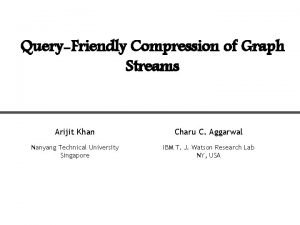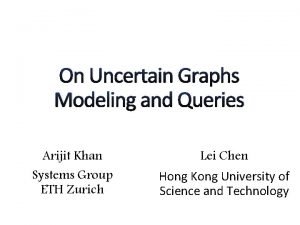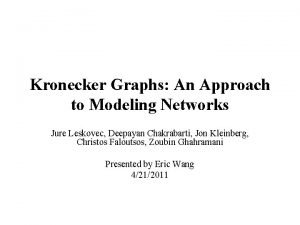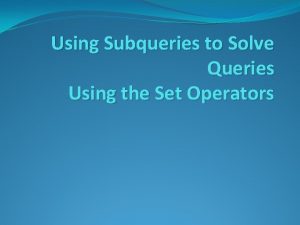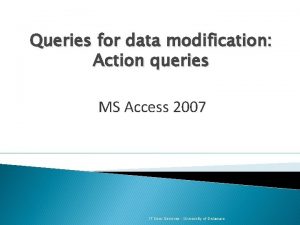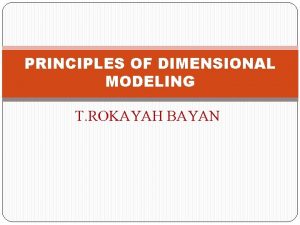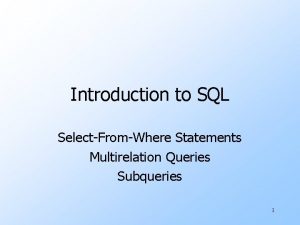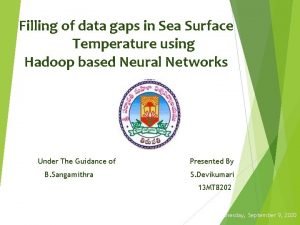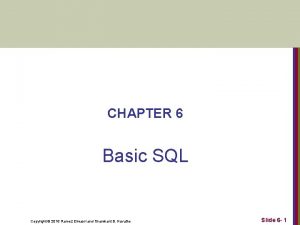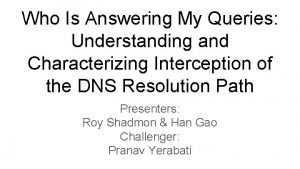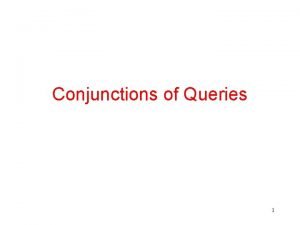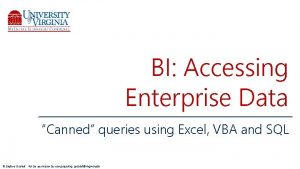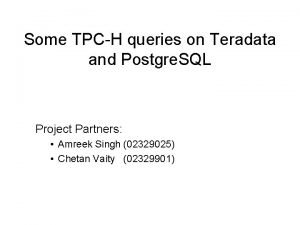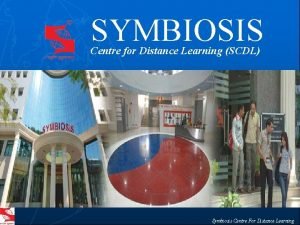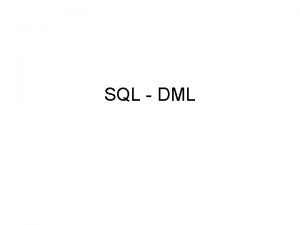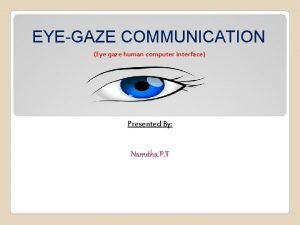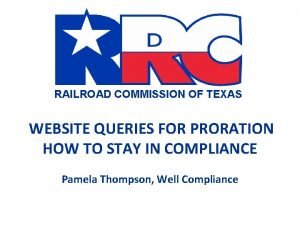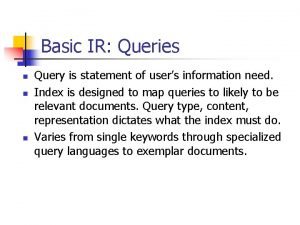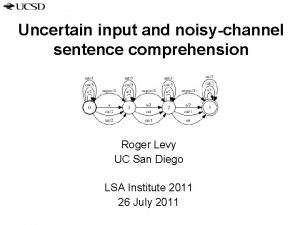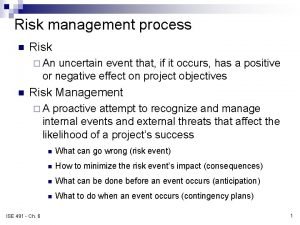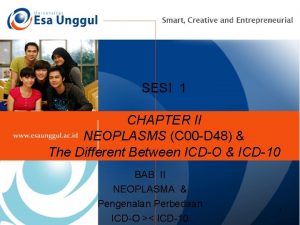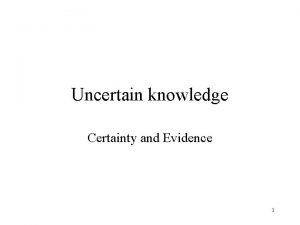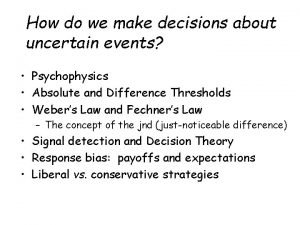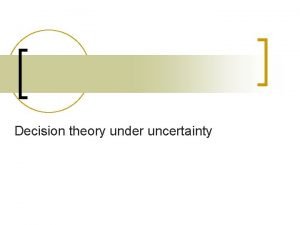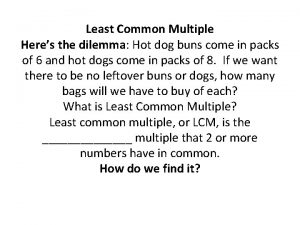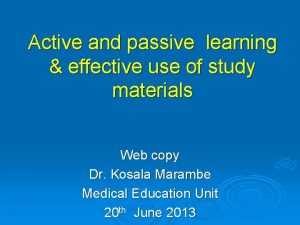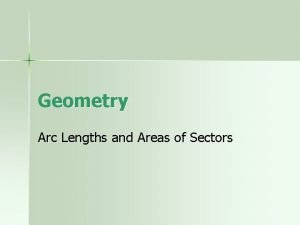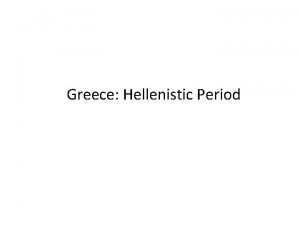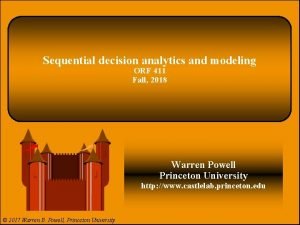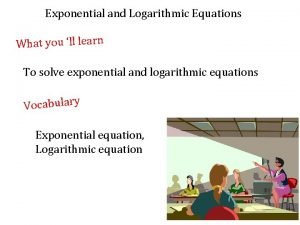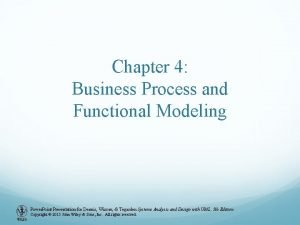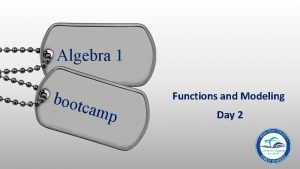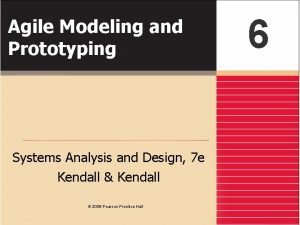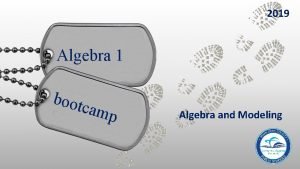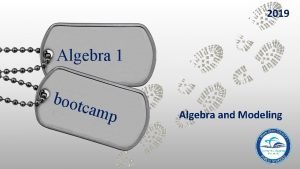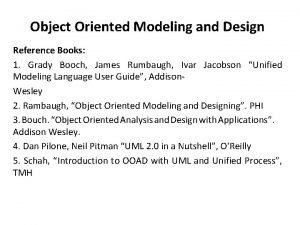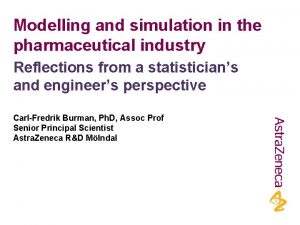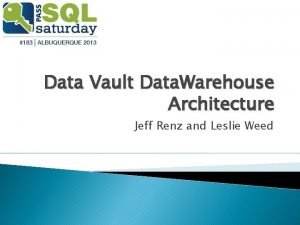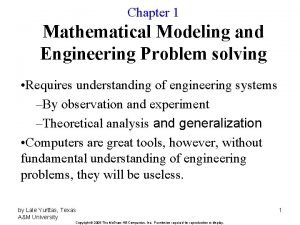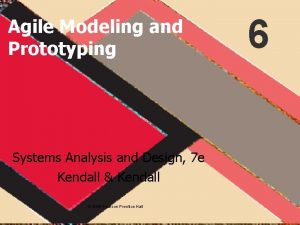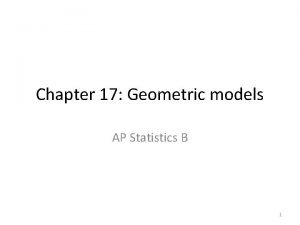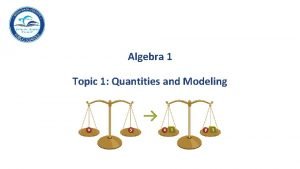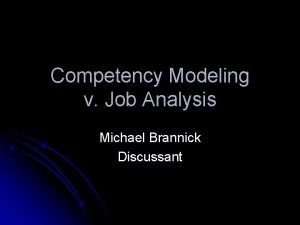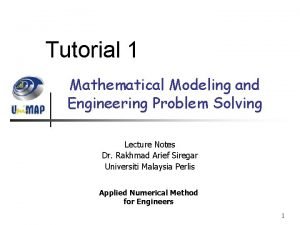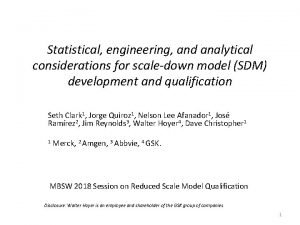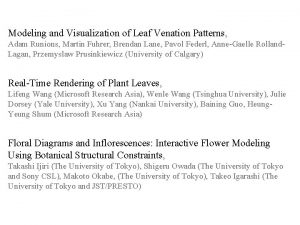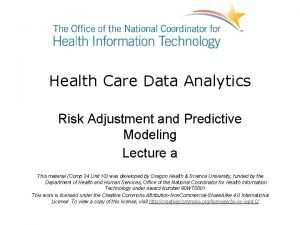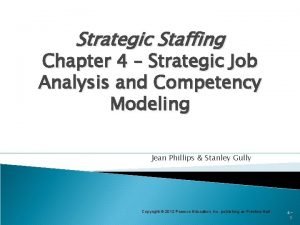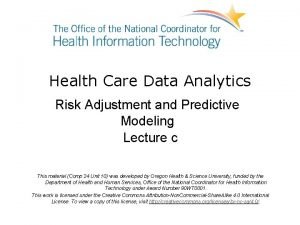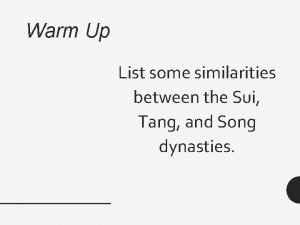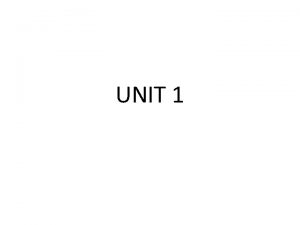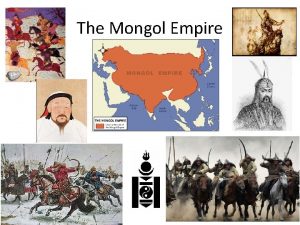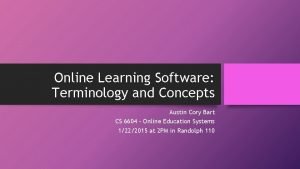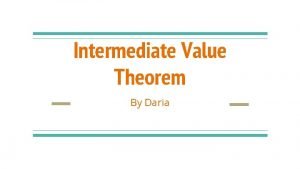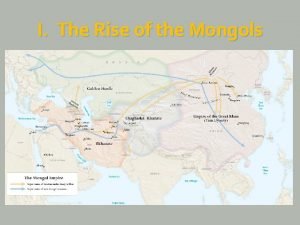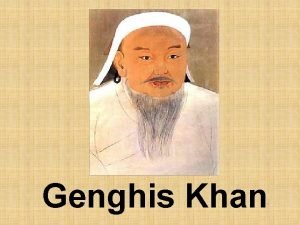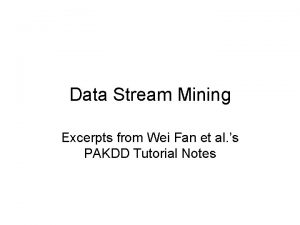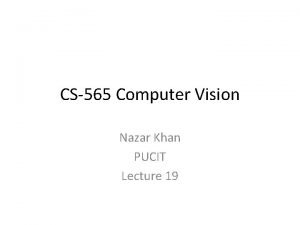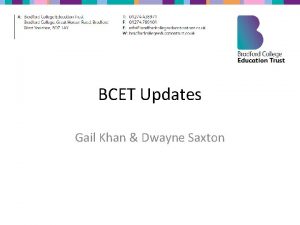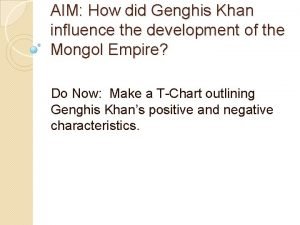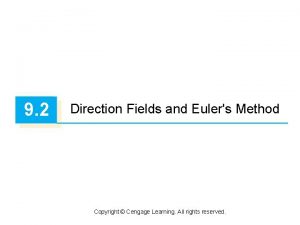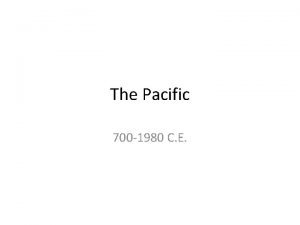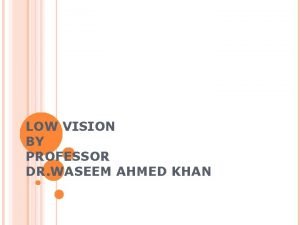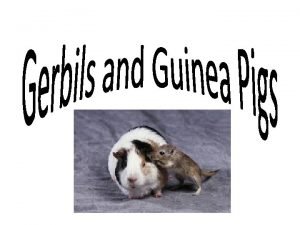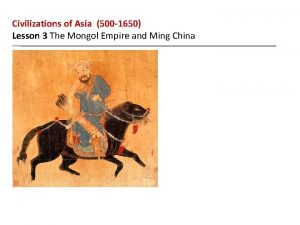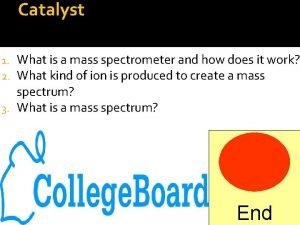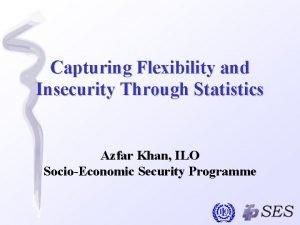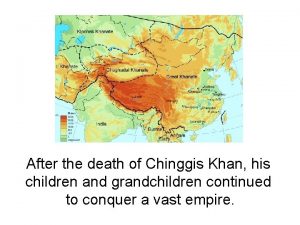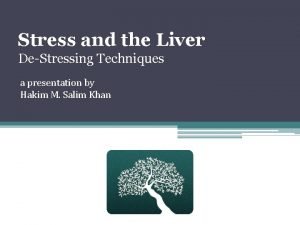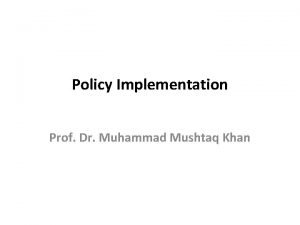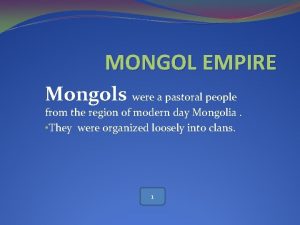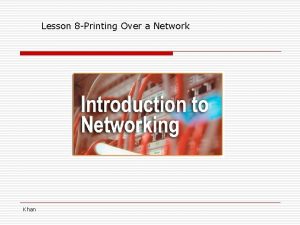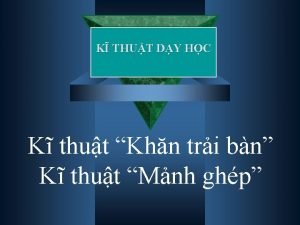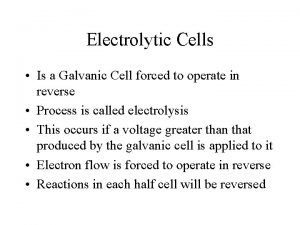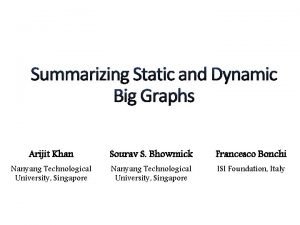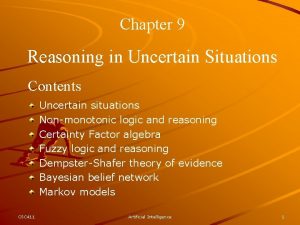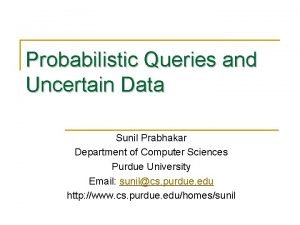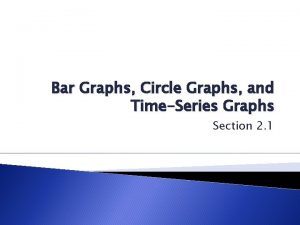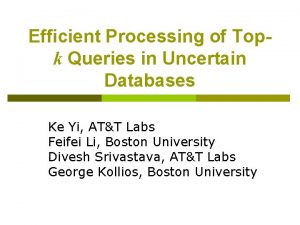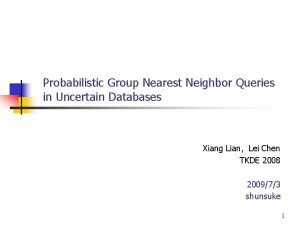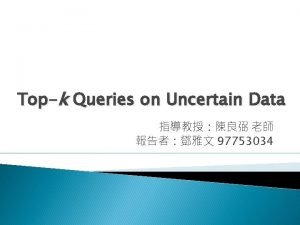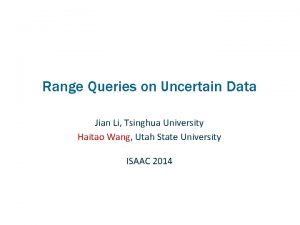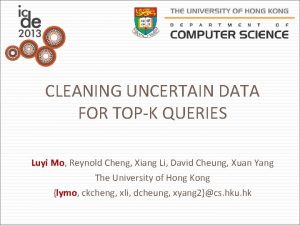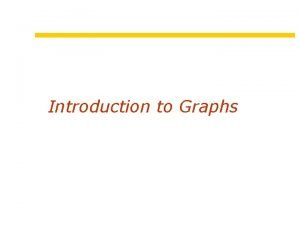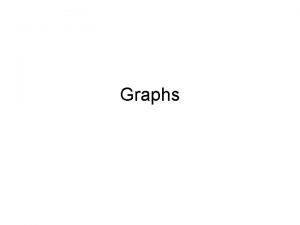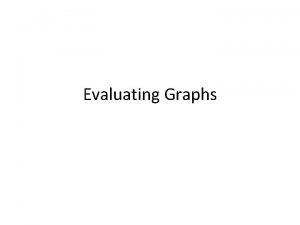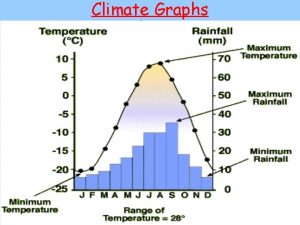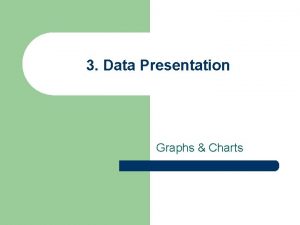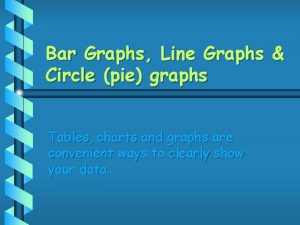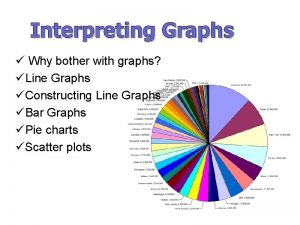On Uncertain Graphs Modeling and Queries Arijit Khan








































![Recursive Sampling for distanceconstraint Reliability [Jin et. al. , VLDB 2011] If inclusion Recursive Sampling for distanceconstraint Reliability [Jin et. al. , VLDB 2011] If inclusion](https://slidetodoc.com/presentation_image_h/0d25abd80a91bd350c92195a99413253/image-41.jpg)
![Recursive Sampling for distanceconstraint Reliability [Jin et. al. , VLDB 2011] , g Recursive Sampling for distanceconstraint Reliability [Jin et. al. , VLDB 2011] , g](https://slidetodoc.com/presentation_image_h/0d25abd80a91bd350c92195a99413253/image-42.jpg)
![Recursive Sampling for distanceconstraint Reliability [Jin et. al. , VLDB 2011] o t Recursive Sampling for distanceconstraint Reliability [Jin et. al. , VLDB 2011] o t](https://slidetodoc.com/presentation_image_h/0d25abd80a91bd350c92195a99413253/image-43.jpg)
![Index for Reliable Set Query [Khan et. al. , EDBT 2011] Reliable Set Query: Index for Reliable Set Query [Khan et. al. , EDBT 2011] Reliable Set Query:](https://slidetodoc.com/presentation_image_h/0d25abd80a91bd350c92195a99413253/image-44.jpg)
![RQ-Tree Index [Khan et. al. , EDBT 2011] 0. 5 S 0. 7 Uout(S, RQ-Tree Index [Khan et. al. , EDBT 2011] 0. 5 S 0. 7 Uout(S,](https://slidetodoc.com/presentation_image_h/0d25abd80a91bd350c92195a99413253/image-45.jpg)








![Pruning Algorithms for Top-K Shortest Path Query UB[Pr(Pr = SP(G))] ≤ 1 - LB[Pr(Pj Pruning Algorithms for Top-K Shortest Path Query UB[Pr(Pr = SP(G))] ≤ 1 - LB[Pr(Pj](https://slidetodoc.com/presentation_image_h/0d25abd80a91bd350c92195a99413253/image-54.jpg)






















































































![More on Influence Maximization Scalable Influence Maximization [Castillo et. al. , KDD 2012] Exact More on Influence Maximization Scalable Influence Maximization [Castillo et. al. , KDD 2012] Exact](https://slidetodoc.com/presentation_image_h/0d25abd80a91bd350c92195a99413253/image-141.jpg)


![Topic-Aware Influence Maximization Topic-aware Social Influence Propagation Models [Barbieri et. al. , ICDM 2012] Topic-Aware Influence Maximization Topic-aware Social Influence Propagation Models [Barbieri et. al. , ICDM 2012]](https://slidetodoc.com/presentation_image_h/0d25abd80a91bd350c92195a99413253/image-144.jpg)









![References - 1 [1] E. Adar and C. Re. Managing Uncertainty in Social Networks. References - 1 [1] E. Adar and C. Re. Managing Uncertainty in Social Networks.](https://slidetodoc.com/presentation_image_h/0d25abd80a91bd350c92195a99413253/image-154.jpg)
![References - 2 [11] C. Budak, D. Agrawal, and A. E. Abbadi. Limiting the References - 2 [11] C. Budak, D. Agrawal, and A. E. Abbadi. Limiting the](https://slidetodoc.com/presentation_image_h/0d25abd80a91bd350c92195a99413253/image-155.jpg)
![References - 3 [21] L. Foschini, J. Hershberger, and S. Suri. On the Complexity References - 3 [21] L. Foschini, J. Hershberger, and S. Suri. On the Complexity](https://slidetodoc.com/presentation_image_h/0d25abd80a91bd350c92195a99413253/image-156.jpg)
![References - 4 [31] Z. Kaoudi and I. Manolescu. Cloud-based RDF Data Management. In References - 4 [31] Z. Kaoudi and I. Manolescu. Cloud-based RDF Data Management. In](https://slidetodoc.com/presentation_image_h/0d25abd80a91bd350c92195a99413253/image-157.jpg)
![References - 5 [41] F. -H. Li, C. -T. Li, and M. -K. Shan. References - 5 [41] F. -H. Li, C. -T. Li, and M. -K. Shan.](https://slidetodoc.com/presentation_image_h/0d25abd80a91bd350c92195a99413253/image-158.jpg)
![References - 6 [51] P. Sevon, L. Eronen, P. Hintsanen, K. Kulovesi, and H. References - 6 [51] P. Sevon, L. Eronen, P. Hintsanen, K. Kulovesi, and H.](https://slidetodoc.com/presentation_image_h/0d25abd80a91bd350c92195a99413253/image-159.jpg)
![References - 7 [61] H. Zhou, A. A. Shaverdian, H. V. Jagadish, and G. References - 7 [61] H. Zhou, A. A. Shaverdian, H. V. Jagadish, and G.](https://slidetodoc.com/presentation_image_h/0d25abd80a91bd350c92195a99413253/image-160.jpg)
- Slides: 160

On Uncertain Graphs Modeling and Queries Arijit Khan Systems Group ETH Zurich Lei Chen Hong Kong University of Science and Technology

Graphs are Everywhere Social Network Chemical Compound Program Flow Transportation Network Biological Network Images Graphs in Machine Learning 1/ 160

Big-Data as Big-Graph Stanford Maryland Harvard Sergey Brin ed st d e at u ad to fo Microsoft Ajim Premji gr founded Bill Gates we nt ed i ud liv Bache lo Of En r g. at d de un Jane Stanford ize nality natio n er quart cit ded foun Wipro head Jerry Yang founded nationality Yahoo! Google Steve Woznaik fo un Seattle founded de d Founded in lives in Ne. XT Silicon Valley Apple Knowledge Graph 3 2/ 160

Uncertainty “… the real world is always certain; it is our knowledge of it that is sometimes uncertain. ” Amihai Motro [Management of Uncertainty in Database Systems] 3/ 160

Uncertainty in Graph Data 0. 5 S 0. 7 0. 1 U 0. 6 Social Networks 0. 2 0. 5 W T V 0. 3 Uncertain Graph (Edge Uncertainty) 0. 6 Traffic Networks Ad-hoc Mobile Networks Protein-interaction Networks Knowledge Bases Constructed from Diverse Sources 4/ 160

Sources of Uncertain Graphs Biological Networks http: //string-db. org/ BIOMINE https: //www. cs. helsinki. fi/group/biomine/ Interaction network of Mic 17 obtained from the STRING database. All interactions are derived from experimental evidence Gabriele Cavallaro [Genome-wide analysis of eukaryotic twin CX 9 C proteins] http: //www. ncbi. nlm. nih. gov// 5/ 160

Sources of Uncertain Graphs Social Networks 0. 3 0. 2 0. 7 0. 6 0. 4 Probability of an edge (u, v) represents the likelihood that some action of u will be adopted by v David Clarke [http: //mashable. com/2012/04/03/twitter-changes-for-brands/] 6/ 160

Other Sources of Uncertain Graphs 0. 1 0. 5 0. 2 0. 6 Sensor Networks Traffic Networks 0. 7 Knowledge Bases 0. 5 0. 3 0. 6 Packet Delivery Probability in Sensor Network Entity Resolution via Crowd-Sourcing ith Link Prediction Wei Wang sw Explicit Manipulation due to privacy purposes rk Wo Uncertain Query Jiawei Han 0. 3 Wei Wang th i sw k or W Identity Uncertainty [ICDE 2014] Crowd-Sourced Entity Resolution [VLDB 2012] 7/ 160

Why Consider Uncertainty Considering the edge probabilities as weights - no meaningful way to perform such a casting - no easy way to additionally encode normal weights on the edges Setting a threshold value to the edge probabilities and ignore any edge below that value - deciding what the right value of the threshold Often we are interested in the probability that a certain property holds, rather than a binary Yes/No answer 8/ 160

Challenges with Uncertain Graphs Uncertainty Semantics Computational Complexity 9/ 160

Challenges with Uncertain Graphs Uncertainty Semantics Computational Complexity 9/ 160

Semantics: Shortest Path in Uncertain Graphs Social Networks 1. 0 - ε A S ε T B n 1. 0 B 2 B 1 1. 0 What is the shortest path from S to T? [Assume independent edge probabilities] M. Potamias et. al. [VLDB 2010] 10/ 160

Semantics: Shortest Path in Uncertain Graphs 1. 0 - ε A S ε T B n 1. 0 The probability of the shortest path (S-T) might be arbitrarily small B 2 B 1 1. 0 What is the shortest path from S to T? [Assume independent edge probabilities] M. Potamias et. al. [VLDB 2010] 11/ 160

Semantics: Shortest Path in Uncertain Graphs 1. 0 - ε A S ε T B n 1. 0 B 2 B 1 1. 0 The probability that the most probable path (S-B 1 -B 2 … Bn-T) is indeed the shortest path might be arbitrarily small The most probable path (S-B 1 -B 2 … Bn-T) might still have an arbitrarily small probability What is the shortest path from S to T? [Assume independent edge probabilities] M. Potamias et. al. [VLDB 2010] 12/ 160

Semantics: Shortest Path in Uncertain Graphs Social Networks 1. 0 - ε Expected Shortest-Path Distance: 1. 0 - ε A S ε T B n 1. 0 B 2 B 1 1. 0 What is the shortest path from S to T? [Assume independent edge probabilities] M. Potamias et. al. [VLDB 2010] t s e t r o h s d e t c e p x Is e e h t e c n a path dist ? c i r t e m best 13/ 160

Semantics: Frequent Subgraphs in Uncertain Graphs 0. 1 F 1. 0 B A A 0. 9 E 0. 3 0. 1 0. 2 0. 3 C 0. 5 D B 0. 1 G 1 A 0. 1 E 1. 0 0. 2 0. 3 B 0. 2 C 1. 0 G 2 0. 5 B 0. 2 C D G 3 0. 2 G 4 0. 8 D F 0. 8 B 0. 3 C G 5 0. 5 A 0. 1 D B 0. 1 0. 3 C G 6 [Assume independent edge probabilities] Support = 6 Expected Support = 0. 038 A 1. 0 E 0. 2 A 1. 0 E 0. 1 F C Is sub-graph (ABC) frequent? [Zou et. al. , CIKM 2009; Papapetrou et. al. , EDBT 2011] D t r o p p u s d e t c e p x Is e ? c i r t e m the best 14/ 160

Semantics: Frequent Subgraphs in Uncertain Graphs A 0. 9 E 0. 3 0. 1 0. 2 A 0. 1 0. 2 Social Networks F 1. 0 B 0. 3 C 0. 5 D B 0. 1 G 1 A 0. 1 E 1. 0 0. 2 0. 3 B 0. 2 C 1. 0 G 2 0. 5 B 0. 2 C D G 3 0. 2 G 4 0. 8 D How certain can we be that those edges are frequent? A 1. 0 E 0. 2 F A 1. 0 E 0. 1 F C 0. 8 B 0. 3 C G 5 0. 5 A 0. 1 D B 0. 1 0. 3 C G 6 [Assume independent edge probabilities] Expected support of edge (AE) = Expected support of edge (CD) = 3 D Frequentness Probability [Bernecker et. al. , KDD 2009] e h t t a h t y t i l i b a b h p Pro a r g ub s a f o t r suppo p u S n i M t is at leas 15/ 160

Tutorial Outline Data as Uncertain Graphs q q Sources of Uncertain Graphs Application and Challenges of Uncertain Graphs What is Uncertain Modeling of Uncertain Graphs Queries over Uncertain Graphs q Reliability Queries: Reachability, Shortest Path, Nearest Neighbor q Pattern Matching Queries q Similarity-based Search q Influence Maximization Open Problems 18 16/ 160

Tutorial Outline Data as Uncertain Graphs q q Sources of Uncertain Graphs Application and Challenges of Uncertain Graphs What is Uncertain Modeling of Uncertain Graphs Queries over Uncertain Graphs q Reliability Queries: Reachability, Shortest Path, Nearest Neighbor q Pattern Matching Queries q Similarity-based Search q Influence Maximization Open Problems 19 16/ 160

This tutorial is not about … Device Network Reliability: Two-terminal reliability, All-terminal reliability, kterminal reliability (Reliability Evaluation: A Comparative Study of Different Techniques. Micro. Rel. , 1975) Generative Models for Graphs: Preferential attachment, Forest fire, Erdős–Rényi (Graphs over Time: Densification Laws, Shrinking Diameters and Possible Explanations. KDD 2005) Uncertain Graphs Mining: Frequent pattern mining (CIKM 2009, EDBT 2011), Clustering/ Community detection (TKDE 2011, ICDM 2012), Classification (SDM 2013), Core decomposition (KDD 2014) Uncertain Databases: Incomplete uncertain databases (MUD 2010), May. BMS (ICDE 2008), Probabilistic Queries (SIGMOD 2003), Possibilistic databases (IEEE T. Fuzzy Sys. 2005) Probabilistic Graphical Models: Bayesian network, Markov random field, Belief propagation Uncertainty Theory: Dempster–Shafer theory, Aleatory vs. Epistemic uncertainty, Possibilistic graphs 20 17/ 160

Tutorial Outline Data as Uncertain Graphs q q Sources of Uncertain Graphs Application and Challenges of Uncertain Graphs What is Uncertain Modeling of Uncertain Graphs Queries over Uncertain Graphs q Reliability Queries: Reachability, Shortest Path, Nearest Neighbor, Centrality q Pattern Matching Queries q Similarity-based Search q Influence Maximization Open Problems 21 18/ 160

0. 8 What is Uncertain? Edge Uncertainty Edge Existence q Edge existence probability q Edge strength based on edge-attributes Node Uncertainty 0. 9 Music Lady Gaga q Node existence probability q Identity uncertainty 0. 7 Fashion 0. 2 Politics Edge Strength based on Attributes ith q Uncertainty about attribute values q Unknown attribute values sw Attribute Uncertainty rk Wo Wei Wang Jiawei Han h it 0. 3 Wei Wang ks or w W Identity Uncertainty

Modeling of Uncertain Graphs Uncertain Graph is a generative model for deterministic graphs Independent Probability q Independent probability of existence on graph components q A graph with m uncertain components generates 2 m possible worlds 0. 3 0. 8 0. 14 Uncertain Graph 0. 06 0. 56 0. 24 22 = 4 Possible Worlds/ Certain Graphs Conditional Probability q Probability conditioned on existence of other graph components q E. g. , congestion probabilities on roads in an intersection 20/ 160

Independent Probability Model A graph with m uncertain components generates 2 m possible worlds Probability of observing any possible world G = (V, EG) sampled from uncertain graph G = (V, E, p) is: 0. 3 0. 8 0. 14 Uncertain Graph (Edge Uncertainty) 0. 06 0. 56 0. 24 22 = 4 Possible Worlds/ Certain Graphs 21/ 160

Tutorial Outline Data as Uncertain Graphs q q Sources of Uncertain Graphs Application and Challenges of Uncertain Graphs What is Uncertain Modeling of Uncertain Graphs Queries over Uncertain Graphs q Reliability Queries: Reachability, Shortest Path, Nearest Neighbor q Pattern Matching Queries q Similarity-based Search q Influence Maximization Open Problems 25 22/ 160

Reliability Query over Uncertain Graphs Two-Terminal Reliability: Find the probability of reaching a destination node T from a source node S Applications: ü Mobile Ad-hoc Networks: find the probability of delivering a packet from a source node to a sink node ü Biological Networks: predicting cocomplex memberships and new interactions requires to compute all proteins that are reachable from a source protein with higher probability ü Social Networks: find the probability that a tweet by some user will be reached to another user U 0. 5 S 0. 7 0. 1 0. 6 0. 2 0. 5 0. 3 T V 0. 6 W Packet Delivery Probability in Mobile Ad-hoc Networks 23/ 160

Formal Definition of Reliability 0. 5 S 0. 7 0. 1 U 0. 6 0. 2 0. 5 W U T V 0. 3 Uncertain Graph (G) 0. 6 Sample Edges T S V W A Certain Graph/ Possible World (G) 24/ 160

Complexity of Reliability Computation Two-terminal reliability computation is a #P-complete problem Counting Problem: Given a graph G = (V, E) together with node and/or edge weights, find the number of sub-graphs that satisfy property X. 25/ 160

Complexity of Reliability Computation Two-terminal reliability computation is a #P-complete problem Counting Problem: Given a graph G = (V, E) together with node and/or edge weights, find the number of sub-graphs that satisfy property X. #P: Those counting problems with the property that, given a candidate sub-graph, testing whether or not it satisfies property X can be accomplished in polynomial time The counting version of any problem in NP is in #P 25/ 160

Complexity of Reliability Computation Two-terminal reliability computation is a #P-complete problem Counting Problem: Given a graph G = (V, E) together with node and/or edge weights, find the number of sub-graphs that satisfy property X. #P: Those counting problems with the property that, given a candidate sub-graph, testing whether or not it satisfies property X can be accomplished in polynomial time The counting version of any problem in NP is in #P #P-Complete: Those problems in #P with the property that if a polynomial algorithm exists for one of them, then a polynomial algorithm exists for all members of #P #P-Complete problems are at least as hard as NP-Complete problems 25/ 160

Complexity of Reliability Computation Two-terminal reliability computation is a #P-complete problem p Proof Sketch Reliability Polynomial: S p p U p p p W T V p p Uncertain Graph (G) Coefficient fi is the number of subsets of edges of cardinality i, such that when a subset is deleted, there still remains a path from S to T By determining fi , we immediately know the number of minimum cardinality (S, T)-cuts Counting minimum cardinality (S, T)-cuts is #P-complete L. G. Valiant [SIAM J. Comp 1979]; M. O. Ball [IEE Tran. Rel. 1986] 26/ 160

Complexity of Reliability Computation Two-terminal reliability on special graph structures Linear time over tree networks U Linear time over series/ parallel networks S #P-complete over planar graphs #P-complete over directed acyclic graphs J. S. Provan et. al. [SIAM J. Comp 1983] T V G is not series/parallel w. r. t. S and T, but is series/parallel w. r. t. U and V 27/ 160

Exact Reliability Computation State Enumeration A graph with m uncertain edges generates 2 m possible worlds Exponential! Pathset Enumeration An (S, T)-pathset is a minimal set of edges whose existence ensures a path from S to T P 1, P 2, …, Pr are path sets Cutset Enumeration An (S, T)-cutset is a minimal set of edges whose deletion leaves no path from S to T C 1, C 2, …, Ck are cut sets 28/ 160

Exact Reliability Computation Inclusion-Exclusion Principle Right-hand-side contains 2 r terms Number of pathsets and cutsets can be exponential in the number of nodes and edges Polynomial-time algorithm exists to compute R(S, T) in the number of (S, T)-cutsets [Provan et. al. , Operations Research 1984] Exploiting special structures [Agrawal et. al. , Operations Research , 1984], upper and lower bounds [Esary et. al. , Technometrics , 1966], efficient Monte Carlo methods [Karp et. al. , UC Berkeley Tech. Report , 1983] 29/ 160

Monte Carlo Sampling to Estimate Reliability Basic Monte-Carlo/ Hit-and-Miss Monte-Carlo Sample K possible graphs, G 1, G 2, …, GK of uncertain graph G according to edge probabilities Compute IS, T(Gi) = 1 if T is reachable from S in Gi, and IS, T(Gi) = 0 otherwise Time Complexity n = # nodes, m = # edges 30/ 160

Basic Monte Carlo with Breadth-First-Search Do not sample all edges in the beginning Only sample the outgoing edges from the currently visited vertex Stop when T is reached, or no new vertex can be reached with the sampled edges 0. 5 S 0. 7 0. 1 U 0. 6 0. 2 0. 5 W U T V 0. 3 Uncertain Graph (G) S 0. 6 Sample + BFS W Start BFS from S 36 31/ 160

Basic Monte Carlo with Breadth-First-Search Do not sample all edges in the beginning Only sample the outgoing edges from the currently visited vertex Stop when T is reached, or no new vertex can be reached with the sampled edges 0. 5 S 0. 7 0. 1 U 0. 6 0. 2 0. 5 W U T V 0. 3 Uncertain Graph (G) T S 0. 6 Sample + BFS V W - Continue BFS from U and W - Terminate 37 32/ 160

Accuracy Guarantees for Basic Monte Carlo Unbiased estimator Variance due to binomial distribution ~ B(K, R(S, T)) G. S. Fishman [IEEE Tran. Rel. 1986] 38 33/ 160

Accuracy Guarantees for Basic Monte Carlo Number of trials necessary to achieve an (ɛ, δ) algorithm Having No of samples ≥ , we ensure Follows from Chernoff bound [M. Potamias et. al. VLDB 2010] One can also apply Chebychev’s inequality [Karp et. al. , UC Berkeley Tech. Report , 1983] or Central Limit Theorem [M. Y. ATA. , Applied Math. , 2006] to derive similar bounds 39 34/ 160

Asking Reliability Query Differently Distance-Constraint Reliability Find the probability that the distance from source node S to a destination node T is less than or equal to a user-defined threshold d [Jin et. al. , VLDB 2011] Reliable Set Query Given a source nodes S, find all other nodes that are reachable from S with probability greater than or equal to a user-defined threshold η [Khan et. al. , EDBT 2014] 40 35/ 160
![Recursive Sampling for distanceconstraint Reliability Jin et al VLDB 2011 If inclusion Recursive Sampling for distanceconstraint Reliability [Jin et. al. , VLDB 2011] If inclusion](https://slidetodoc.com/presentation_image_h/0d25abd80a91bd350c92195a99413253/image-41.jpg)
Recursive Sampling for distanceconstraint Reliability [Jin et. al. , VLDB 2011] If inclusion set E 1 contains a d-path from S to T, then If exclusion set E 2 contains a d-cut for S to T, then Enumeration tree for recursive computation of distance-constraint reachability 41 36/ 160
![Recursive Sampling for distanceconstraint Reliability Jin et al VLDB 2011 g Recursive Sampling for distanceconstraint Reliability [Jin et. al. , VLDB 2011] , g](https://slidetodoc.com/presentation_image_h/0d25abd80a91bd350c92195a99413253/image-42.jpg)
Recursive Sampling for distanceconstraint Reliability [Jin et. al. , VLDB 2011] , g n i s s i m e r a s e g d e e m o r s e n h t e o h e W m o s f o e nc. e t s n e a r v p e l e e th r r e g n o l o n e r a s e g ed a e r a h s s e l p g m a n i s t s y i n x a e f M o n o i t r o p t n a c i f i n e sig h t , s e g d d e l g u n o i c s t s i s o c g or m n i k c he c y t i l i b a. Enumeration tree for recursive computation m e reach h t g on m a d e r of distance-constraint reachability be sha Dynamic Monte-Carlo, Zhu et. al. , DASFAA 2011 42 37/ 160
![Recursive Sampling for distanceconstraint Reliability Jin et al VLDB 2011 o t Recursive Sampling for distanceconstraint Reliability [Jin et. al. , VLDB 2011] o t](https://slidetodoc.com/presentation_image_h/0d25abd80a91bd350c92195a99413253/image-43.jpg)
Recursive Sampling for distanceconstraint Reliability [Jin et. al. , VLDB 2011] o t e g d e t x e n f o Selection iciency eff e v o r p im g n i l p m a s y t i l i b a b ro p l a u zq t i e v r Un o H , z t i w r u e H c n n a e i s r a n e v (Ha c u d e r o t ) n o s p m Tho Enumeration tree for recursive computation of distance-constraint reachability 43 38/ 160
![Index for Reliable Set Query Khan et al EDBT 2011 Reliable Set Query Index for Reliable Set Query [Khan et. al. , EDBT 2011] Reliable Set Query:](https://slidetodoc.com/presentation_image_h/0d25abd80a91bd350c92195a99413253/image-44.jpg)
Index for Reliable Set Query [Khan et. al. , EDBT 2011] Reliable Set Query: Given a source nodes S, find all other nodes that are reachable from S with probability greater than or equal to a userdefined threshold η Can we quickly determine the nodes that are certainly not reachable from S with probability greater than or equal to ɳ 0. 5 S 0. 7 U 0. 6 Indexing (offline) – RQ Tree 0. 1 0. 2 0. 5 W T V Filtering + Verification (Online) 0. 6 0. 3 ɳ = 0. 5 Uncertain Graph 44 39/ 160
![RQTree Index Khan et al EDBT 2011 0 5 S 0 7 UoutS RQ-Tree Index [Khan et. al. , EDBT 2011] 0. 5 S 0. 7 Uout(S,](https://slidetodoc.com/presentation_image_h/0d25abd80a91bd350c92195a99413253/image-45.jpg)
RQ-Tree Index [Khan et. al. , EDBT 2011] 0. 5 S 0. 7 Uout(S, *)=0 0. 1 U T 0. 2 0. 5 V 0. 6 W 0. 3 ɳ = 0. 5 Uncertain Graph S, U, W, V, T Uout(S, *)=0. 496 ɳ = 0. 5 S, U, W V, T Uout(S, *)=0. 8 S, W U V T Uout(S, *)=0. 8 S W RQ-Tree Index 45 40/ 160

Pruning Capacity: RQ-Tree Index # Nodes # Edges Edge Prob: Mean, SD, Quartiles DBLP 684 911 4 569 982 0. 14 ± 0. 11, {0. 09, 0. 18} Flickr 78 322 20 343 018 0. 09 ± 0. 06, {0. 06, 0. 07, 0. 09} Bio. Mine 1 008 201 13 445 048 0. 27 ± 0. 21, {0. 12, 0. 22, 0. 36} Dataset Characteristics Precision of RQ-Tree Filtering Phase 46 41/ 160

Shortest Path Query Uncertain and edge-weighted graph G = (V, E, W, p) 10, 0. 6 S 15, 0. 7 A 5, 0. 8 5, 0. 4 B 20, 0. 5 C D 20, 0. 8 10, 0. 9 E A 20 15, 0. 8 Shortest Path Distribution 10 5 S C T 15 10 E 25, 0. 4 B D T 25 Possible World Graph G 1 Uncertain Edge-Weighted Graph (G) D A Shortest Path Distribution S 15 T C B 10 E 25 Possible World Graph G 2 47

Distance Metric in Uncertain Graphs Median Distance Majority Distance Expected Reliable Distance M. Potamias et. al. [VLDB 2010] 43/ 160

Distance Metric in Uncertain Graphs Median Distance Majority Distance Expected Reliable Distance M. Potamias et. al. [VLDB 2010] e r o m s i e n o h c i h W t a h w r o f suitable ? s n o i t a c appli y l e r s c i r t e m e c n a Dist th a p e n o on d e s a b y Proximit – Random ? s e r u s a Me d e z i l a n o rs e P , k l a W ! k n a R e g Pa 44/ 160

Nearest Neighbor Query Find the top-k nearest neighbors of a given query node based on distance metrics defined previously #P-hard Pruning Techniques: Find top-k nearest neighbors without computing distances to all nodes from S M. Potamias et. al. [VLDB 2010] 50 45/ 160

Pruning Algorithms for Nearest Neighbor Query Median Distance-based Pruning Initialize D to a small value. Only consider nodes that are within distance D from query node S If k nodes found with median distance less than D, terminate Pruning Criteria Otherwise increase D and repeat M. Potamias et. al. [VLDB 2010] 51 46/ 160

Variations of Shortest Path Query Threshold-based Shortest Path Query Given a source node S, a destination node T, and a probability threshold η, find a path set {P 1, P 2, …, Pr} from S to T, such that each path Pi has a shortest path probability larger than threshold η [Cheng et. al. , DASFAA 2014] Top-k Shortest Path Query Given a source node S and a destination node T, find a set of k paths {P 1, P 2, …, Pr} from S to T, such that their shortest path probabilities are the largest among all possible shortest paths from S to T [Zou et. al. , WISE 2011] 52 52 47/ 160

Pruning Algorithms for Top-K Shortest Path Query Top-r shortest paths {P 1, P 2, P 3, …, Pr} from S to T in certain graph G* by Yen’s algorithm [J. Y. Yen, Management Science 1971] Probability that Pr is the shortest path from S to T in uncertain graph G is given by none of the paths {P 1, P 2, P 3, …, Pr-1} exists and Pr exists. Upper bound: UB[Pr(Pr = SP(G))] Lower bound: LB[Pr(Pr = SP(G))] �� = K-th largest lower bound found so far Terminate if UB[Pr(Pr = SP(G))] < �� Zou et. al. [WISE 2011] Pruning Criteria 53 48/ 160
![Pruning Algorithms for TopK Shortest Path Query UBPrPr SPG 1 LBPrPj Pruning Algorithms for Top-K Shortest Path Query UB[Pr(Pr = SP(G))] ≤ 1 - LB[Pr(Pj](https://slidetodoc.com/presentation_image_h/0d25abd80a91bd350c92195a99413253/image-54.jpg)
Pruning Algorithms for Top-K Shortest Path Query UB[Pr(Pr = SP(G))] ≤ 1 - LB[Pr(Pj = SP(G))] First Lower Bound Second Lower Bound Si: Edge-set cover for the paths { (Pi – Pr): i ∈ (1, r-1) } S’i: Pairwise independent set covers Zou et. al. [WISE 2011] 54 49/ 160

Reliability with Edge Colors Uncertain, edge-colored multi-graph G Given a source node S and destination node T, find the top-k edge colors that maximize the reliability from S to T 0. 6 S 0. 4 A 0. 7 0. 8 0. 2 0. 7 B C T 0. 5 Uncertain, Edge-Colored Multi-Graph: Select at most K edge-colors Barbieri et. al. [ICDM 2012]; Chen er. al. [DASFAA 2014]; Khan et. al. [CIKM 2015] 55 50/ 160

Reliability with Edge Colors Uncertain, edge-colored multi-graph G Given a source node S and destination node T, find the top-k edge colors that maximize the reliability from S to T 0. 6 S 0. 4 A 0. 7 0. 6 0. 8 0. 2 0. 7 B C Green and Red T 0. 5 Uncertain, Edge-Colored Multi-Graph: Select at most 2 edge-colors Khan et. al. [CIKM 2015] S A 0. 7 C 0. 2 0. 7 B T 0. 5 Reliability: R(S, T) = 0 56 51/ 160

Reliability with Edge Colors Uncertain, edge-colored multi-graph G Given a source node S and destination node T, find the top-k edge colors that maximize the reliability from S to T 0. 6 S 0. 4 A 0. 7 C 0. 8 0. 2 0. 7 B 0. 6 Green and Blue T 0. 5 Uncertain, Edge-Colored Multi-Graph: Select at most 2 edge-colors Khan et. al. [CIKM 2015] A 0. 8 S 0. 4 C 0. 7 T B Reliability: R(S, T) = 0. 28 57 52/ 160

Reliability with Edge Colors Uncertain, edge-colored multi-graph G Given a source node S and destination node T, find the top-k edge colors that maximize the reliability from S to T 0. 6 S 0. 4 A 0. 7 A 0. 8 0. 2 0. 7 B C Red and Blue T 0. 5 Uncertain, Edge-Colored Multi-Graph: Select at most 2 edge-colors Khan et. al. [CIKM 2015] S 0. 4 0. 7 C 0. 8 0. 2 T B 0. 5 Reliability: R(S, T) = 0. 29 58 53/ 160

Reliability with Edge Colors Uncertain, edge-colored multi-graph G Given a source node S and destination node T, find the top-k edge colors that maximize the reliability from S to T 0. 6 S 0. 4 A 0. 7 0. 8 0. 2 0. 7 B Applications C T 0. 5 Uncertain, Edge-Colored Multi-Graph: Select at most K edge-colors Khan et. al. [CIKM 2015] Top-k enzymes to create pathways in biological networks Top-k Advertisement contents for topic-aware information cascade Top-k themes to organize a party among a group of people 59 54/ 160

What if Correlated Probabilities A S C B state(e. CT)=1 state(e. CT)=0 state(e. AC)=1, state(e. BC)=1 0. 5 state(e. AC)=1, state(e. BC)=0 0. 75 0. 25 state(e. AC)=0, state(e. BC)=1 0. 7 0. 3 state(e. AC)=0, state(e. BC)=0 0. 4 0. 6 D T E Uncertain Graph (G) Conditional Probability Table If DAG, sample each edge of G according to their topological order If not a DAG, obtaining independent samples is more difficult Gibbs sampling Potamias et. al. [VLDB 2010]; Cheng et. al. [DASFAA 2014] 60 55/ 160

Summary: Reliability Queries Two-terminal reliability computation over uncertain graphs is a #Pcomplete problem Several variations of reliability query – shortest path, nearest neighbors, reliable set, edge-colored reliability Application-specific semantics for shortest paths, nearest neighbors, edge-color and uncertainty Efficient indexing and sampling techniques, pruning algorithms 61 56/ 160

Tutorial Outline Data as Uncertain Graphs q q Sources of Uncertain Graphs Application and Challenges of Uncertain Graphs What is Uncertain Modeling of Uncertain Graphs Queries over Uncertain Graphs q Reliability Queries: Reachability, Shortest Path, Nearest Neighbor q Pattern Matching Queries q Similarity-based Search q Influence Maximization Open Problems 62 57/ 160

Why Uncertain Graphs In our daily life, uncertainty is ubiquitous! Protein-Protein Interaction Network Social Networks Protein-Protein Interaction Networks False Positive > 45% Social Networks Probabilistic Trust/Influence Model 58/ 160

Why Uncertain Graphs Uncertain graph has many applications. In these applications, graph data is usually noisy and incomplete, which leads to uncertain graphs. STRING database (http: //string-db. org) is a data source that contains PPIs with uncertain edges provided by biological experiments. q Subjective reasons: imprecise physical instrument, network delay, complex sensing q Objective reasons: privacy-preserving, information extraction, data integration Therefore, it is important to study query processing on large uncertain graphs. 59/ 160

Our Roadmap … Pattern Matching Queries Efficient Subgraph Search Efficient Supergraph Search Efficient Pattern Graph Search 60/ 160

Probabilistic Subgraph Search Uncertain graph Vertex uncertainty (existence probability) Edge uncertainty (existence probability given its two endpoints) Y. Yuan et. al. [VLDB 2011] 66 61/ 160

Probabilistic Subgraph Search Uncertain graph Possible worlds: combination of all uncertain edges and vertices Y. Yuan et. al. [VLDB 2011] 67 62/ 160

Probabilistic Subgraph Search Problem Definition Given: an uncertain graph database G={g 1, g 2, …, gn}, a query graph q and probability threshold τ Query: find all gi ∈G, such that the subgraph isomorphic probability is not smaller than τ. Subgraph isomorphic probability (SIP): The SIP between q and gi = the sum of gi’s possible worlds to which q is subgraph isomorphic Y. Yuan et. al. [VLDB 2011] 68 63/ 160

Probabilistic Subgraph Search Problem Definition Subgraph isomorphic probability (SIP) g + + q + + = 0. 27 It is #P-complete to calculate SIP Y. Yuan et. al. [VLDB 2011] 69 64/ 160

Probabilistic Subgraph Search Probabilistic Subgraph Query Processing Framework Naïve method:sequence scan D, and decide if the SIP between q and gi is not smaller than threshold τ. g 1 graph isomorphic to g 2 : NP-hard? g 1 subgraph isomorphic to g 2 : NP-Complete Calculating SIP: #P-Complete Naïve method: very costly, infeasible! Y. Yuan et. al. [VLDB 2011] 70 65/ 160

Probabilistic Subgraph Search A Filtering-and-Verification Query Processing Framework {g 1, g 2, . . , gn} {g’ 1, g’ 2, . . , g’m} Filtering Candidates Query q {g” 1, g” 2, . . , g”k} Answers Y. Yuan et. al. [VLDB 2011] Verification 71 66/ 160

Probabilistic Subgraph Search Filtering: Structural Pruning Principle: if we remove all the uncertainty from g, and the resulting graph still does not contain q, then the original uncertain graph cannot contain q. g q Theorem: if q gc,then Pr(q g)=0 Y. Yuan et. al. [VLDB 2011] 72 67/ 160

Probabilistic Subgraph Search Filtering: Probabilistic Pruning Let f be a feature of gc i. e. , f gc Rule 1: if f q , Upper. B(Pr(f g))< ,then g is pruned. ∵ f q, ∴ Pr(q g) Pr(f g)< Uncertain Graph Y. Yuan et. al. [VLDB 2011] Feature Query & 73 68/ 160

Probabilistic Subgraph Search Filtering: Probabilistic Pruning Rule 2: if q f, Lower. B(Pr(f g)) ,then g is an answer. ∵ q f, ∴ Pr(q g) Pr(f g) Uncertain Graph Feature Query & Two main issues for probabilistic pruning q How to derive lower and upper bounds of SIP? q How to select features with great pruning power? Y. Yuan et. al. [VLDB 2011] 74 69/ 160

Probabilistic Subgraph Search Technique 1: calculation of lower and upper bounds Lemma: Let Bf 1, …, Bf|Ef|be all embeddings of f in gc, then Pr(f g)=Pr(Bf 1 … Bf|Ef|). Upper. B(Pr(f g)): Y. Yuan et. al. [VLDB 2011] 75 70/ 160

Probabilistic Subgraph Search Technique 1: calculation of lower and upper bounds Lower. B(Pr(f g)): Tightest Lower. B(f) Converting into computing the maximum clique of graph b. G Y. Yuan et. al. [VLDB 2011] 76 71/ 160

Probabilistic Subgraph Search Technique 1: calculation of lower and upper bounds Exact value V. S. Upper and lower bound Value Y. Yuan et. al. [VLDB 2011] Computing Time 77 72/ 160

Probabilistic Subgraph Search Technique 2: Optimal Feature Selection If we index all features, we will have the most pruning power index. But it is also very costly to query such index. Thus we would like a small number of features but with the greatest pruning power. Cost model: Max gain = sequence scan cost– query index cost Integer programming maximum set coverage: NP-complete. Use the greedy algorithm to approximate it. Y. Yuan et. al. [VLDB 2011] 78 73/ 160

Probabilistic Subgraph Search Technique 2: Optimal Feature Selection Integer programming:greedy algorithm Approximate optimal index within 1 -1/e Feature Matrix Y. Yuan et. al. [VLDB 2011] Probabilistic Index 79 74/ 160

Probabilistic Subgraph Search Probabilistic Index Construct a string for each feature Construct a prefix tree for all feature strings Construct an invert list for all leaf nodes Y. Yuan et. al. [VLDB 2011] 80 75/ 160

Probabilistic Subgraph Search Verification: Iterative bound pruning Lemma: Pr(q g)=Pr(Bq 1 … Bq|Eq|) Unfolding: Let Based on Inclusion-Exclusion Principle Iterative Bound Pruning Y. Yuan et. al. [VLDB 2011] 81 76/ 160

Our Roadmap … Pattern Matching Queries Efficient Subgraph Search Efficient Supergraph Search Efficient Pattern Graph Search 77/ 160

Probabilistic Supergraph Search Back to our example of the uncertain graph database The existing probability of the specific vertex A. The conditional probability of the edge Figure 1: An Uncertain Graph Database B-C appears when the nodes B and C already exist. Y. Tong et. al. [CIKM 2014] 83 78/ 160

Probabilistic Supergraph Search Back to our example of the uncertain graph database Pr(PW 6)=0. 9*0. 8*(1 -0. 9)=0. 0576 The condition probabilities of A-C and B-C are not considered since the node C does not exist. We derive 18 possible world graphs Y. Tong et. al. [CIKM 2014] 84

Probabilistic Supergraph Search Back to our example of the uncertain graph database SIP(q, ug 2)=0. 419904+0. 046656= 0. 46656 Y. Tong et. al. [CIKM 2014] 85

Probabilistic Supergraph Search Supergraph Containment Probability (SCP) Given an uncertain graph ug and a query graph q, the SCP between q and ug is equal to the sum of the probabilities of ug’s possible worlds where ug is subgraph of q Probabilistic Supergraph Containment Search Given an uncertain graph database G={g 1, g 2, …, gn}, a query graph q and probability threshold τ. Query: find all gi ∈G, such that the supergraph containment probability is not smaller than τ. Y. Tong et. al. [CIKM 2014] 86 81/ 160

Probabilistic Supergraph Search Supergraph Containment Probability (SCP) SCP(q, ug 2)=0. 002+0. 018+…+0. 001296+0. 005184 =0. 352 Y. Tong et. al. [CIKM 2014] 87

Probabilistic Supergraph Search Whether the existing approach of probabilistic subgraph search can be extended to solve the issue of probabilistic supergraph? The answer set of q in the corresponding deterministic graph database The final answer set of q in the uncertain graph database The answer set of q in The final answer set Dq UGDthe corresponding q of q in the uncertain deterministic graph The framework of probabilistic subgraph search is not suitable for graph database the problem of probabilistic supergraph search! UGDq Subgraph Search Y. Tong et. al. [CIKM 2014] Dq Supergraph Search 88

Probabilistic Supergraph Search Complexity Analysis However, we prove that it is #P-hard to calculate the supergraph containment probability (SCP) of a given uncertain graph and a query graph. How to compute this hard problem? Y. Tong et. al. [CIKM 2014] 89 84/ 160

Probabilistic Supergraph Search A Filtering-and-Verification Query Processing Framework Offline Index Construction (Using Existing Work) q Mining probabilistic frequent subgraphs, which are considered as feature set to build index Filtering Phase q Probabilistic-supergraph-filtering-logic-based pruning Verification Phase q Sampling-based algorithm (Unequal-Probability Sampling) Y. Tong et. al. [CIKM 2014] 90 85/ 160

Probabilistic Supergraph Search Filtering: Probabilistic Pruning Principle: If a feature graph and , then Theorem: If a feature graph and , where τ is the probabilistic threshold, then ug can be pruned safely! Y. Tong et. al. [CIKM 2014] 91 86/ 160

Probabilistic Supergraph Search The Example of Probabilistic Pruning SIP(f, ug 2)=0. 4199+0. 0466=0. 46656>1 -0. 7=0. 3, SCP(q, ug 2) must be lower than the given threshold. Thus, ug 2 can be pruned safely. Y. Tong et. al. [CIKM 2014] 92

Probabilistic Supergraph Search Verification Solutions Simple-Random-Sampling-based Approach Analysis of Simple-Random-Sampling-based Approach q This method is unbiased. q However, its variance is , which is larger. Y. Tong et. al. [CIKM 2014] 93 88/ 160

Probabilistic Supergraph Search Verification Solutions: Simple-Random-Sampling-based Approach Analysis of Simple-Random-Sampling-based Approach q This method is unbiased. q However, its variance is , which is larger. Y. Tong et. al. [CIKM 2014] 94 89/ 160

Probabilistic Supergraph Search Verification Solutions: Unequal-Probability-Sampling-based Approach The stopping condition 1 means that all subsequent sampled possible world graphs must be contained by the given query graph Early Pruning The stopping condition 2 means that all subsequent sampled possible world graphs must Simple-Random-Sampling Unequal-Probability Sampling NOT be contained by the given query graph Y. Tong et. al. [CIKM 2014]

Our Roadmap … Pattern Matching Queries Efficient Subgraph Search Efficient Supergraph Search Efficient Pattern Graph Search 91/ 160

Probabilistic Pattern Graph Matching Deterministic Graph Pattern Matching Given a graph G and a query q with distance constraint γ q Vertex labeled G and q An answer m is a set of vertices in G: q A vertex in m has the same label as a vertex in G q Any pair of vertices has a shortest path distance ≤ γ Y. Yuan et. al. [CIKM 2014] 97 92/ 160

Probabilistic Pattern Graph Matching Deterministic Graph Pattern Matching Distance constraint γ=3 q Correct answer: {2, 5, 7}, {5, 6, 7} q Incorrect answer: {1, 5, 7}: distance between 1 and 7=4> γ Y. Yuan et. al. [CIKM 2014] 98 93/ 160

Probabilistic Pattern Graph Matching Probabilistic Graph Pattern Matching Distance constraint γ=3 q Vertex is deterministic q Edge uncertainty (existence probability) Y. Yuan et. al. [CIKM 2014] 99 94/ 160

Probabilistic Pattern Graph Matching Probabilistic Graph Pattern Matching Possible worlds: combination of all uncertain edges Uncertain Graph Y. Yuan et. al. [CIKM 2014] 29 =512 possible worlds 100 95/ 160

Probabilistic Pattern Graph Matching Problem Definitions Given: an uncertain graph G, a query graph q and a probability threshold Query: find all matches {m} in G, such that the pattern matching probability is not smaller than . Pattern matching probability (PMP): The PMP of m in G = the sum of G’s possible worlds in which m is a valid match. For example, m={2, 5, 7} : PMP of m in G= 0. 01248+0. 009126+. . . =0. 65. It is #P-complete to calculate PMP Y. Yuan et. al. [CIKM 2014] 101 96/ 160

Probabilistic Pattern Graph Matching Framework Naïve method:in G enumerate all vertex sets {m} with size of V(q), and decide if the PMP of m in G is not smaller than threshold . Number of {m}= Comb(|G |, |V(q)|) Calculating PMP: #P-Complete Naïve method: very costly, infeasible! Y. Yuan et. al. [CIKM 2014] 102 97/ 160

Probabilistic Pattern Graph Matching A Filtering-and-Verification Query Processing Framework G: {m 1, m 2, . . , ma} {m’ 1, m’ 2, . . , m’b} Candidates Filtering Query q {m” 1, m” 2, . . , m”c} Answers Y. Yuan et. al. [CIKM 2014] Verification 103 98/ 160

Probabilistic Pattern Graph Matching Filtering: Structural Pruning We remove all the uncertainty from G, and obtain the resulting vertex sets {m} after certain pattern matching on G, then the vertex sets {m} is input for the uncertain filtering. {2, 5, 7}, {5, 6, 7}, {1, 2, 4}, … Y. Yuan et. al. [CIKM 2014] 104 99/ 160

Probabilistic Pattern Graph Matching Probabilistic Index Edge cut: a set of edges whose removing results in a partition of G Edge cut: {e 1, e 2, …, ef} Connected probability: Y. Yuan et. al. [CIKM 2014] 105 100/ 160

Probabilistic Pattern Graph Matching Probabilistic Index Structure: PI is a tree structure. Each node of PI is a vertex of G, and each edge of PI indexes a edge cut. In PI, suppose a path (s, t) has an edge, then the indexed edge cut is a cut of (s, t) in G. G Index Y. Yuan et. al. [CIKM 2014] 106 101/ 160

Probabilistic Pattern Graph Matching Filtering: Probabilistic Pruning Lemma: Let Bc 1, …, Bc|Mc| be the cuts of m in Gc, and Bc 1, …, Bc|IN| be the disjoint cuts, then Many groups of disjoint cuts Many upper bounds Best upper bound Maximum packing set problem. Y. Yuan et. al. [CIKM 2014] 107 102/ 160

Probabilistic Pattern Graph Matching Filtering: Probabilistic Pruning One-by-one algorithm: scan the candidate match set {m 1, m 2, …, mk}, and for mi, if Upper. B(mi) ≤ γ, mi can be pruned. Collective algorithm: Y. Yuan et. al. [CIKM 2014] 108 103/ 160

Tutorial Outline Data as Uncertain Graphs q q Sources of Uncertain Graphs Application and Challenges of Uncertain Graphs What is Uncertain Modeling of Uncertain Graphs Queries over Uncertain Graphs q Reliability Queries: Reachability, Shortest Path, Nearest Neighbor q Pattern Matching Queries q Similarity-based Search q Influence Maximization Open Problems 109 104/ 160

Probabilistic Subgraph Similarity Search Uncertain graph: q Vertices are deterministic q Edge uncertainty: neighbor edges are corrected Road Network Y. Yuan et. al. [VLDB 2012] 110 105/ 160

Probabilistic Subgraph Similarity Search Possible worlds: combination of all uncertain edges Y. Yuan et. al. [VLDB 2012] 111 106/ 160

Probabilistic Pattern Graph Matching Problem Definitions Given: an uncertain graph database G={g 1, g 2, …, gn}, a query graph q and probability threshold ε Query: find all gi ∈G, such that the subgraph similarity probability is not smaller than ε. Subgraph similarity probability (SSP): q The SSP between q and gi = the sum of gi’s possible worlds g’ to which q is subgraph similar q q is subgraph similar to g’: the distance between g’ and q is not larger than a distance threshold q Subgraph distance between q and g’= |q|-|MCS(q, g)| where MCS(q, g) is the maximum common subgraph of q and g’. Y. Yuan et. al. [VLDB 2012] 112 107/ 160

Probabilistic Subgraph Similarity Search Problem Definitions Subgraph similar probability (SSP) g + Y. Yuan et. al. [VLDB 2012] q + + …… It is #P-complete to calculate SSP = 0. 45 113

Probabilistic Subgraph Similarity Search Probabilistic Subgraph Similarity Query Processing Framework Naïve method:sequence scan D, and decide if the SSP between q and gi is not smaller than threshold ε. g 1 subgraph isomorphic to g 2 : NP-Complete the distance between g 1 and g 2 : NP-Complete Calculating SSP: #P-Complete Naïve method: very costly, infeasible! Y. Yuan et. al. [VLDB 2012] 114 109/ 160

Probabilistic Subgraph Similarity Search A Filtering-and-Verification Query Processing Framework {g 1, g 2, . . , gn} Structure pruning Query q {g’ 1, g’ 2, . . , g’l} Prob. pruning (two rules) Candidates {g”’ 1, g”’ 2, . . , g’”k} Answers Y. Yuan et. al. [VLDB 2012] {g’’ 1, g’’ 2, . . , g’’m} Verification 115 110/ 160

Probabilistic Subgraph Similarity Search Filtering: Structural Pruning Principle: if we remove all the uncertainty from g, and the resulting graph is still not subgraph similar to q, then the original uncertain graph cannot approximately contain q. g q Theorem: if q simgc,then Pr(q simg)=0 Y. Yuan et. al. [VLDB 2012] 116 111/ 160

Probabilistic Subgraph Similarity Search Filtering: Probabilistic Pruning Probabilistic index: Each column of the matrix corresponds to an uncertain graph, and each row corresponds to an indexed feature. The entry gives the upper and lower bounds of the subgraph isomorphism probability (SIP) of feature f to g. Y. Yuan et. al. [VLDB 2012] 117 112/ 160

Probabilistic Subgraph Similarity Search Filtering: Probabilistic Pruning let U={rq 1, …, rqa} be a graph set after q relaxing edges. For each rqi, in the index, we find a graph feature fi 1 such that fi 1 rqi. Rule 1:If Usim=Upper. B(Pr(q sim g))=Upper. B(fi 1) +…+ Upper. B(fa 1) < ε, then g is pruned. g q U sim =0. 4+0. 1=0. 5 Y. Yuan et. al. [VLDB 2012] 118 113/ 160

Probabilistic Subgraph Similarity Search Filtering: Probabilistic Pruning let U={rq 1, …, rqa} be a graph set after q relaxing edges. For each rqi, we find two graph features (fi 1, fi 2) such that fi 1 rqi and rqi fi 2 Rule 2:If Lsim=Lower. B(Pr(q sim g))=Σ 1 a. Lower. B(fi 2)–Σ 1≤i, j≤a Upper. B(fi 2) Upper. B(fj 2) >ε,then g is an answer. Lsim=0. 28+0. 09 -0. 36*0. 15=0. 31 Y. Yuan et. al. [VLDB 2012] 114/ 160

Probabilistic Subgraph Similarity Search Tightest Upper Bound of SSP If there are 10 features and 10 graphs after relaxation, we get 10 10 Usim Solution: converting it into the set cover problem U sim =(0. 4+0. 1=0. 5) or (0. 1+0. 5=0. 6) or (0. 4+0. 5=0. 9) Y. Yuan et. al. [VLDB 2012] 120 115/ 160

Probabilistic Subgraph Similarity Search Tightest Lower Bound of SSP Solution: Converting it into the quadratic programming Y. Yuan et. al. [VLDB 2012] 121 116/ 160

Tutorial Outline Data as Uncertain Graphs q q Sources of Uncertain Graphs Application and Challenges of Uncertain Graphs What is Uncertain Modeling of Uncertain Graphs Queries over Uncertain Graphs q Reliability Queries: Reachability, Shortest Path, Nearest Neighbor q Pattern Matching Queries q Similarity-based Search q Influence Maximization Open Problems 122 117/ 160

Information Diffusion in Social Networks 2008 U. S. Presidential Election Emergencies such as Hurricanes Ike and Gustav in 2008 Demonstration in Egypt, 2011 Death of Michael Jackson in 2009 0. 3 0. 2 0. 7 0. 6 0. 4 118/ 160

Influence Maximization in Social Networks Find a small subset of influential individuals in a social network, such that they can influence the largest number of people in the network 0. 6 0. 7 0. 8 0. 9 0. 8 0. 4 Viral Marketing 119/ 160

Influence Maximization in Social Networks Find a small subset of influential individuals in a social network, such that they can influence the largest number of people in the network 0. 6 0. 7 0. 8 0. 9 0. 8 0. 4 Viral Marketing 120/ 160

Influence Maximization in Social Networks Find a small subset of influential individuals in a social network, such that they can influence the largest number of people in the network 0. 6 0. 7 0. 8 0. 9 0. 8 0. 4 Viral Marketing 121/ 160

Influence Maximization in Social Networks Find a small subset of influential individuals in a social network, such that they can influence the largest number of people in the network 0. 6 0. 7 0. 8 0. 9 0. 8 0. 4 Viral Marketing 122/ 160

Related Tutorials Information and Influence Spread in Social Networks – Motivation, Applications, Challenges, Data, and Tools for Information diffusion and Influence Maximization [Castillo et. al. , KDD 2012] Information Diffusion In Social Networks: Observing and Affecting What The Society Cares About – Effect on Network Structure on Information Diffusion [Agrawal et. al. , CIKM 2011] Information Diffusion In Social Networks: Observing and Influencing Societal Interests – Various Information Diffusion Models [Agrawal et. al. , VLDB 2011] 123/ 160

Our Roadmap … Influence Maximization Problem and its Variations Influence Maximization Problem Targeted Influence Maximization Maximizing Product Adoption Topic-Aware Influence Maximization Preventing the Spread of an Existing Negative Campaign Competitive Influence Maximization by Social Network Host Complementary Influence Maximization 124/ 160

Influence Maximization Problem The first influence maximization problem: Markov random fields formulation [Domingos et. al. , KDD 2001] Influence Maximization with [Kempe et. al. , KDD 2003] Discrete Diffusion Model Social network G = (V, E, p) Seed set �� : initial set of nodes influenced directly by the campaigner Influence cascade: Nodes are influenced starting from the seed nodes, in discrete steps and following certain probabilistic influence cascading model Influence spread: Number of influenced nodes when the cascading process starting from the seed set �� ends The Problem: Given a user-defined budget K, find the top-K seed nodes that maximize the expected influence spread 125/ 160

Influence Cascading Models Independent cascade (IC) model, Linear threshold (LT) model [Kempe et. al. , KDD 2003] IC Model 0. 5 0. 6 0. 3 0. 4 0. 8 0. 6 1. 0 0. 7 0. 2 126/ 160

Influence Cascading Models Independent cascade (IC) model, Linear threshold (LT) model [Kempe et. al. , KDD 2003] IC Model 0. 5 0. 6 0. 3 0. 4 0. 8 0. 6 1. 0 0. 7 0. 2 127/ 160

Influence Cascading Models Independent cascade (IC) model, Linear threshold (LT) model [Kempe et. al. , KDD 2003] IC Model 0. 5 0. 6 0. 3 0. 4 0. 8 0. 6 1. 0 0. 7 0. 2 128/ 160

Influence Cascading Models Independent cascade (IC) model, Linear threshold (LT) model [Kempe et. al. , KDD 2003] IC Model 0. 5 0. 6 0. 3 0. 4 0. 8 0. 6 1. 0 0. 7 0. 2 129/ 160

Influence Cascading Models Independent cascade (IC) model, Linear threshold (LT) model [Kempe et. al. , KDD 2003] LT Model 0. 5 0. 9 0. 3 0. 1 0. 7 0. 2 0. 4 0. 1 0. 7 0. 2 0. 3 0. 4 0. 2 0. 3 0. 5 0. 1 130/ 160

Influence Cascading Models Independent cascade (IC) model, Linear threshold (LT) model [Kempe et. al. , KDD 2003] LT Model 0. 5 0. 9 0. 3 0. 1 0. 7 0. 2 0. 4 0. 1 0. 7 0. 2 0. 3 0. 4 0. 2 0. 3 0. 5 0. 1 131/ 160

Influence Cascading Models Independent cascade (IC) model, Linear threshold (LT) model [Kempe et. al. , KDD 2003] LT Model 0. 5 0. 9 0. 3 0. 1 0. 7 0. 2 0. 4 0. 1 0. 7 0. 2 0. 3 0. 4 0. 2 0. 3 0. 5 0. 1 132/ 160

Influence Cascading Models Independent cascade (IC) model, Linear threshold (LT) model [Kempe et. al. , KDD 2003] LT Model 0. 5 0. 9 0. 3 0. 1 0. 7 0. 2 0. 4 0. 1 0. 7 0. 2 0. 3 0. 4 0. 2 0. 3 0. 5 0. 1 133/ 160

Influence Cascading Models Independent cascade (IC) model, Linear threshold (LT) model [Kempe et. al. , KDD 2003] LT Model 0. 5 0. 9 0. 3 0. 1 0. 7 0. 2 0. 4 0. 1 0. 7 0. 2 0. 3 0. 4 0. 2 0. 3 0. 5 0. 1 134/ 160

Influence Maximization: Complexity and Approximation Algorithm Influence maximization under both IC and LT models is NP-hard Expected influence spread is sub-modular and increases monotonically with inclusion of seed nodes Iterative hill-climbing algorithm produces solution with approximation guarantee: Iterative hill-climbing algorithm: Time Complexity: Kempe et. al. [KDD 2003] 135/ 160
![More on Influence Maximization Scalable Influence Maximization Castillo et al KDD 2012 Exact More on Influence Maximization Scalable Influence Maximization [Castillo et. al. , KDD 2012] Exact](https://slidetodoc.com/presentation_image_h/0d25abd80a91bd350c92195a99413253/image-141.jpg)
More on Influence Maximization Scalable Influence Maximization [Castillo et. al. , KDD 2012] Exact Methods (CELF, CELF++, TIM, …) Heuristic Methods (MIA, Community-based approach, Sparsification, Degree Discount IC, …) Other Information Diffusion Models [Agrawal et. al. , VLDB 2011] General Threshold Model Susceptible-Infected-Removed Model Continuous-Time Diffusion ……… 136/ 160

Targeted Influence Maximization A campaigner often promotes her product with a group of target customers in mind Target marketing by maximizing the influence over a region of the social network [Aggarwal et. al. , SDM 2011, Li et. al. , Social. Com 2011] k-effectors — identify k seed nodes such that a given activation pattern can be established [Lappas. al. , KDD 2010] 137/ 160

Maximizing Product Adoption Influence ≠ Adoption Conformity-Aware Influence Maximization U [Li et. al. , VLDB J. 2015] If both U and V adopted, the probability that T will also adopt is: LT-C Model [Bhagat et. al. , WSDM 2012] + V T Signed Network: Each User has a Influence index and a Conformity Index
![TopicAware Influence Maximization Topicaware Social Influence Propagation Models Barbieri et al ICDM 2012 Topic-Aware Influence Maximization Topic-aware Social Influence Propagation Models [Barbieri et. al. , ICDM 2012]](https://slidetodoc.com/presentation_image_h/0d25abd80a91bd350c92195a99413253/image-144.jpg)
Topic-Aware Influence Maximization Topic-aware Social Influence Propagation Models [Barbieri et. al. , ICDM 2012] Online Topic-aware Influence Maximization Queries [Aslay et. al. , EDBT 2014] Online Topic-Aware Influence Maximization [Chen et. al. , VLDB 2015] Topic-aware Influence Maximization [Chen et. al. , VLDB 2015] 139/ 160

Competitive and Complementary Influence Maximization Competitive Influence Maximization Preventing the spread of an existing negative campaign [Bharathi et. al. , WINE 2007] [Borodin et. al. , WINE 2007] [Budak et. al. , WWW 2011] Non-cooperative campaigns who select seeds alternatively [Fazeli et. al. , CDC 2012] [Tzoumas et. al. , WINE 2012] Competing campaigners promote their products at the same time (e. g. , Nintendo’s Wii vs. Sony’s Playstation vs. Microsoft’s X -Box) [Li et. al. , SIGMOD 2015] Complementary Influence Maximization i. Phone 6 and Apple Watch are complementary products [Lu et. al. , VLDB 2016] 140/ 160

Influence Maximization as a Service: Social Network Host’s Perspective Challenges for Campaigners Social Network graph is hidden by the host of the social network (e. g. , Facebook, Twitter, Linked. In) A campaigner (e. g. , AT&T, Sony, Microsoft, Samsung) is unable to identify the top-k seed sets for maximizing her campaign Challenges for Hosts Social network host sells influence maximization service to its client campaigners How does the host select the seed nodes for each of its client campaigners so that the spread of each campaign remains balanced? Lu et. al. [KDD 2013] 141/ 160

Open Problems Finding one good possible world instead of sampling Trade-off between accuracy vs. efficiency Semantics of classical graph queries over uncertain graphs, e. g. , centrality, partitioning, summarization, visualization System design issues for uncertain graphs processing Availability of benchmark datasets, ground-truths, and query results 142/ 160

Open Problem: One Good Possible World Find one deterministic representative instance that maintains the underlying graph properties S 0. 51 W + 0. 97 S W U V - 0. 01 0. 50 0. 52 U V Uncertain Graph + 0. 48 - 0. 50 One Possible Graph (Discrepancy in Degree Distribution) Representative instance for more complex graph properties – Reachability, Subgraph containment ? Parchas et. al. [SIGMOD 2013] 143/ 160

Open Problem: Accuracy vs. Efficiency Parameters controlling accuracy vs. efficiency, false positive vs. false negative rates Reliable Set Computation Most probable path provides a lower bound of reliability No false positive; but can have false negatives S 0. 7 W 0. 7 0. 6 U 0. 8 T Actual Reliable Set of S with threshold 0. 5 = {W, U, T} Reliable Set via Most Probable Path = {W, U} Khan et. al. [EDBT 2014] 144/ 160

Open Problem: Semantics of Classical Queries over Uncertain Graphs Centrality over uncertain graphs – influential nodes are one type of central nodes [Pfeiffer et. al. , Purdue Tech. Report 2011] Partition an uncertain graph Uncertain graph summarization [Hassanlou et. al. , WAIM 2011] Uncertain graph visualization [Cesario et. al. , SPIE 2011] 145/ 160

Open Problem: System Issues Are uncertain databases (Deep. Dive, Bayes. Store, Pr. DB) good for processing uncertain graphs? Should graph databases (Neo 4 J, Orient. DB) support uncertainty? 146/ 160

Open Problem: Benchmark Datasets, Ground-Truths Benchmark datasets Open-source software Ground-truths – how to measure the effectiveness of influence maximization algorithms in real-world? [Castillo et. al. , KDD 2012] 147/ 160

Questions?
![References 1 1 E Adar and C Re Managing Uncertainty in Social Networks References - 1 [1] E. Adar and C. Re. Managing Uncertainty in Social Networks.](https://slidetodoc.com/presentation_image_h/0d25abd80a91bd350c92195a99413253/image-154.jpg)
References - 1 [1] E. Adar and C. Re. Managing Uncertainty in Social Networks. IEEE Data Eng. Bull. , 30(2): 15– 22, 2007. [2] C. C. Aggarwal. Managing and Mining Uncertain Data. Springer, 2009. [3] C. C. Aggarwal, A. Khan, and X. Yan. On Flow Authority Discovery in Social Networks. In SDM, 2011. [4] K. K. Aggarwal, K. B. Misra, and J. S. Gupta. Reliability Evaluation A Comparative Study of Different Techniques. Micro. Rel. , 1975. [5] S. Auer, C. Bizer, G. Kobilarov, J. Lehmann, R. Cyganiak, and Z. Ives. DBpedia: A Nucleus for a Web of Open Data. In ISWC, 2007. [6] N. Barbieri, F. Bonchi, and G. Manco. Topic-Aware Social Influence Propagation Models. In ICDM, 2012. [7] S. Bharathi, D. Kempe, and M. Salek. Competitive Influence Maximization in Social Networks. In WINE, 2007. [8] P. Boldi, F. Bonchi, A. Gionis, and T. Tassa. Injecting Uncertainty in Graphs for Identity Obfuscation. PVLDB, 2012. [9] K. Bollacker, C. Evans, P. Paritosh, T. Sturge, and J. Taylor. Freebase: A Collaboratively Created Graph Database for Structuring Human Knowledge. In SIGMOD, 2008. [10] C. Borgs, M. Brautbar, J. T. Chayes, and B. Lucier. Maximizing Social Influence in Nearly Optimal Time. In SODA, 2014.
![References 2 11 C Budak D Agrawal and A E Abbadi Limiting the References - 2 [11] C. Budak, D. Agrawal, and A. E. Abbadi. Limiting the](https://slidetodoc.com/presentation_image_h/0d25abd80a91bd350c92195a99413253/image-155.jpg)
References - 2 [11] C. Budak, D. Agrawal, and A. E. Abbadi. Limiting the Spread of Misinformation in Social Networks. In WWW, 2011. [12] C. Castillo, W. Chen, and L. V. S. Lakshmanan. Information and Influence Spread in Social Networks. In KDD, 2012. [13] L. Chen and X. Lian. Query Processing over Uncertain and Probabilistic Databases. In DASFAA, 2012. [14] L. Chen and C. Wang. Continuous Subgraph Pattern Search over Certain and Uncertain Graph Streams. IEEE TKDE, 22(8): 1093– 1109, 2010. [15] W. Chen, C. Wang, and Y. Wang. Scalable Influence Maximization for Prevalent Viral Marketing in Large-Scale Social Networks. In KDD, 2010. [16] Y. Chen and D. Z. Wang. Knowledge Expansion over Probabilistic Knowledge Bases. In SIGMOD, 2014. [17] J. B. Collins and S. T. Smith. Network Discovery For Uncertain Graphs. In Fusion, 2014. [18] P. Cudre-Mauroux and S. Elnikety. Graph Data Management Systems for New Application Domains. In VLDB, 2011. [19] P. Domingos and M. Richardson. Mining the Network Value Customers. In KDD, 2001. [20] G. S. Fishman. A Comparison of Four Monte Carlo Methods for Estimating the Probability of s-t Connectedness. IEEE Tran. Rel. , 1986.
![References 3 21 L Foschini J Hershberger and S Suri On the Complexity References - 3 [21] L. Foschini, J. Hershberger, and S. Suri. On the Complexity](https://slidetodoc.com/presentation_image_h/0d25abd80a91bd350c92195a99413253/image-156.jpg)
References - 3 [21] L. Foschini, J. Hershberger, and S. Suri. On the Complexity of Time-Dependent Shortest Paths. In SODA, 2011. [22] J. Ghosh, H. Q. Ngo, S. Yoon, and C. Qiao. On a Routing Problem Within Probabilistic Graphs and its Application to Intermittently Connected Networks. In INFOCOM, 2007. [23] A. Goyal, F. Bonchi, and L. V. S. Lakshmanan. A Data-Based Approach to Social Influence Maximization. PVLDB, 5(1): 73– 84, 2011. [24] A. Goyal, W. Lu, and L. V. S. Lakshmanan. CELF++: Optimizing the Greedy Algorithm for Influence Maximization in Social Networks. In WWW, 2011. [25] M. Han, K. Daudjee, K. Ammar, M. T. ¨Ozsu, X. Wang, and T. Jin. An Experimental Comparison of Pregel-like Graph Processing Systems. PVLDB, 7(12): 1047– 1058, 2014. [26] G. Hardy, C. Lucet, and N. Limnios. K-Terminal Network Reliability Measures With Binary Decision Diagrams. IEEE Tran. Rel. , 2007. [27] M. Hua and J. Pei. Probabilistic Path Queries in Road Networks: Traffic Uncertainty aware Path Selection. In EDBT, 2010. [28] H. Huang and C. Liu. Query Evaluation on Probabilistic RDF Databases. In WISE, 2009. [29] R. Jin, L. Liu, B. Ding, and H. Wang. Distance-Constraint Reachability Computation in Uncertain Graphs. PVLDB, 4(9): 551– 562, 2011. [30] R. Jin, L. Liu, B. Ding, and H. Wang. Distance-Constraint Reachability Computation in Uncertain Graphs. PVLDB, 2011.
![References 4 31 Z Kaoudi and I Manolescu Cloudbased RDF Data Management In References - 4 [31] Z. Kaoudi and I. Manolescu. Cloud-based RDF Data Management. In](https://slidetodoc.com/presentation_image_h/0d25abd80a91bd350c92195a99413253/image-157.jpg)
References - 4 [31] Z. Kaoudi and I. Manolescu. Cloud-based RDF Data Management. In SIGMOD, 2014. [32] D. Kempe, J. M. Kleinberg, and E. Tardos. Maximizing the Spread of Influence through a Social Network. In KDD, 2003. [33] A. Khan, F. Bonchi, A. Gionis, and F. Gullo. Fast Reliability Search in Uncertain Graphs. In EDBT, 2014. [34] A. Khan and S. Elnikety. Systems for Big-Graphs. PVLDB, 7(13): 1709– 1710, 2014. [35] A. Khan, Y. Wu, and X. Yan. Emerging Graph Queries in Linked Data. In ICDE, 2012. [36] E. Kharlamov and P. Senellart. Modeling, Querying, and Mining Uncertain XML Data. In A. Tagarelli, editor, XML Data Mining: Models, Methods, and Applications, pages 29– 52. IGI Global, 2011. [37] J. Kim, S. -K. Kim, and H. Yu. Scalable and Parallelizable Processing of Influence Maximization for Large-Scale Social Networks? In ICDE, 2013. [38] D. L. -Nowell and J. Kleinberg. The Link Prediction Problem for Social Networks. In CIKM, 2003. [39] T. Lappas, E. Terzi, D. Gunopulos, and H. Mannila. Finding Effectors in Social Networks. In KDD, 2010. [40] J. Leskovec, A. Krause, C. Guestrin, C. Faloutsos, J. Van. Briesen, and N. Glance. Cost-effective Outbreak Detection in Networks. In KDD, 2007.
![References 5 41 F H Li C T Li and M K Shan References - 5 [41] F. -H. Li, C. -T. Li, and M. -K. Shan.](https://slidetodoc.com/presentation_image_h/0d25abd80a91bd350c92195a99413253/image-158.jpg)
References - 5 [41] F. -H. Li, C. -T. Li, and M. -K. Shan. Labeled Influence Maximization in Social Networks for Target Marketing. In Social. Com/PASSAT, 2011. [42] J. Li. Algorithms for Mining Uncertain Graph Data. In KDD, 2012. [43] R. -H. Li, J. X. Yu, R. Mao, and T. Jin. Efficient and Accurate Query Evaluation on Uncertain Graphs via Recursive Stratified Sampling. In ICDE, 2014. [44] X. Lian and L. Chen. Efficient Query Answering in Probabilistic RDF Graphs. In SIGMOD, 2011. [45] J. C. Liu, X. Q. Shang, Y. Meng, and M. Wang. Mining Maximal Dense Subgraphs in Uncertain PPI Network. Applied Mechanics and Materials, 135: 609– 615, 2011. [46] W. E. Moustafa, A. Kimmig, A. Deshpande, and L. Getoor. Subgraph Pattern Matching over Uncertain Graphs with Identity Linkage Uncertainty. In ICDE, 2014. [47] P. Parchas, F. Gullo, D. Papadias, and F. Bonchi. The Pursuit of a Good Possible World: Extracting Representative Instances of Uncertain Graphs. In SIGMOD, 2014. [48] J. Pei, M. Hua, Y. Tao, and X. Lin. Query Answering Techniques on Uncertain and Probabilistic Data: Tutorial Summary. In SIGMO, 2008. [49] M. Potamias, F. Bonchi, A. Gionis, and G. Kollios. k-Nearest Neighbors in Uncertain Graphs. PVLDB, 2010. [50] M. Renz, R. Cheng, H. -P. Kriegel, A. Zufle, and T. Bernecker. Similarity Search and Mining in Uncertain Databases. PVLDB, 3(2): 1653– 1654, 2010.
![References 6 51 P Sevon L Eronen P Hintsanen K Kulovesi and H References - 6 [51] P. Sevon, L. Eronen, P. Hintsanen, K. Kulovesi, and H.](https://slidetodoc.com/presentation_image_h/0d25abd80a91bd350c92195a99413253/image-159.jpg)
References - 6 [51] P. Sevon, L. Eronen, P. Hintsanen, K. Kulovesi, and H. Toivonen. Link Discovery in Graphs Derived from Biological Databases. In DILS, 2006. [52] A. Sharafat and O. Ma’rouzi. All-Terminal Network Reliability Using Recursive Truncation Algorithm. IEEE Tran. on Rel. , 2009. [53] D. Suciu, D. Olteanu, R. Christopher, and C. Koch. Probabilistic Databases. 2011. [54] Y. Tang, X. Xiao, and Y. Shi. Influence Maximization: Near-Optimal Time Complexity Meets Practical Efficiency. In SIGMOD, 2014. [55] L. G. Valiant. The Complexity of Enumeration and Reliability Problems. SIAM J. on Computing, 1979. [56] J. Wang, T. Kraska, M. J. Franklin, and J. Feng. Crowd. ER: Crowdsourcing Entity Resolution. In VLDB, 2012. [57] Y. Yuan, L. Chen, and G. Wang. Efficiently Answering Probability Threshold-Based Shortest Path Queries over Uncertain Graphs. In DASFAA, 2010. [58] Y. Yuan, G. Wang, and L. Chen. Pattern Match Query in a Large Uncertain Graph. In CIKM, 2014. [59] Y. Yuan, G. Wang, L. Chen, and H. Wang. Efficient Subgraph Similarity Search on Large Probabilistic Graph Databases. In VLDB, 2012. [60] Y. Yuan, G. Wang, H. Wang, and L. Chen. Efficient Subgraph Search over Large Uncertain Graphs. PVLDB, 4(11), 2011.
![References 7 61 H Zhou A A Shaverdian H V Jagadish and G References - 7 [61] H. Zhou, A. A. Shaverdian, H. V. Jagadish, and G.](https://slidetodoc.com/presentation_image_h/0d25abd80a91bd350c92195a99413253/image-160.jpg)
References - 7 [61] H. Zhou, A. A. Shaverdian, H. V. Jagadish, and G. Michailidis. Querying Graphs with Uncertain Predicates. In MLG, 2010. [62] K. Zhu, W. Zhang, G. Zhu, Y. Zhang, and X. Lin. BMC: An Efficient Method to Evaluate Probabilistic Reachability Queries. In DASFAA, 2011. [63] Z. Zou, H. Gao, and J. Li. Discovering Frequent Subgraphs over Uncertain Graph Databases under Probabilistic Semantics. In KDD, 2010. [64] Z. Zou, J. Li, H. Gao, and S. Zhang. Frequent Subgraph Pattern Mining on Uncertain Graph Data. In CIKM, 2009. [65] Z. Zou, J. Li, H. Gao, and S. Zhang. Mining Frequent Subgraph Patterns from Uncertain Graph Data. IEEE Trans. Knowl. Data Eng. , 22(9): 1603– 1218, 2010. [66] Y. Tong, X. Zhang, C. Cao and L. Chen. Efficient Probabilistic Supergraph Search over Large Uncertain Graphs. In CIKM, 2014.
 Arijit khan
Arijit khan Arijit khan
Arijit khan Helen c. erickson nursing theory
Helen c. erickson nursing theory Dimensional modeling vs relational modeling
Dimensional modeling vs relational modeling Transition bugs in software testing
Transition bugs in software testing Graphs that enlighten and graphs that deceive
Graphs that enlighten and graphs that deceive Kronecker graphs: an approach to modeling networks
Kronecker graphs: an approach to modeling networks Graphs that compare distance and time are called
Graphs that compare distance and time are called End behavior chart
End behavior chart Sql queries for insert update and delete
Sql queries for insert update and delete Suggestions and queries
Suggestions and queries Using subqueries to solve queries
Using subqueries to solve queries Standing query
Standing query Action queries in access
Action queries in access Principles of dimensional modeling
Principles of dimensional modeling Multirelation queries
Multirelation queries Wildcard queries in information retrieval
Wildcard queries in information retrieval Thank you any queries
Thank you any queries Complex sql join queries
Complex sql join queries Basic retrieval queries in sql
Basic retrieval queries in sql Hotel.hotelno=room.hotelno(hotel room)
Hotel.hotelno=room.hotelno(hotel room) Answering my queries
Answering my queries World importers
World importers Sql queries for banking database
Sql queries for banking database Conjunctive queries
Conjunctive queries Stefano grazioli
Stefano grazioli Ingres algorithm
Ingres algorithm Teradata ordbms
Teradata ordbms For any queries
For any queries Scdl faculty
Scdl faculty Sql queries
Sql queries Any queries
Any queries J query
J query Disadvantages of eye gaze communication system
Disadvantages of eye gaze communication system Rrc completion query
Rrc completion query Texas railroad commission online queries
Texas railroad commission online queries Sql server management studio recover unsaved queries
Sql server management studio recover unsaved queries Ir queries
Ir queries Certain vs uncertain digits
Certain vs uncertain digits Levy in a sentence
Levy in a sentence Explain uncertain agreement
Explain uncertain agreement Uncertain event example
Uncertain event example Icd 10 tumor gaster
Icd 10 tumor gaster Representing knowledge in an uncertain domain
Representing knowledge in an uncertain domain Uncertain events
Uncertain events Indifference curve risk averse
Indifference curve risk averse Four model approach
Four model approach Linear and quadratic functions and modeling
Linear and quadratic functions and modeling Dfd chapter 5
Dfd chapter 5 Language translator
Language translator Genghis khan and babur
Genghis khan and babur The hot dog buns dilemma answers
The hot dog buns dilemma answers Active vs passive learning
Active vs passive learning Find the missing sector areas and arc lengths
Find the missing sector areas and arc lengths Great altar of zeus and athena at pergamon khan academy
Great altar of zeus and athena at pergamon khan academy Networks and graphs circuits paths and graph structures
Networks and graphs circuits paths and graph structures Creating and interpreting graphs and tables
Creating and interpreting graphs and tables Simulation modeling and analysis law kelton
Simulation modeling and analysis law kelton Sequential decision analytics and modeling
Sequential decision analytics and modeling Modeling with exponential and logarithmic equations quiz
Modeling with exponential and logarithmic equations quiz Answers key
Answers key System requirements checklist output example
System requirements checklist output example Business process and functional modeling
Business process and functional modeling Business process and functional modeling
Business process and functional modeling Unplanned model aba
Unplanned model aba Albert bandura imitation
Albert bandura imitation Algebra 1 bootcamp functions and modeling answer key
Algebra 1 bootcamp functions and modeling answer key 2019 algebra 1 bootcamp answers
2019 algebra 1 bootcamp answers Algebra 1 boot camp
Algebra 1 boot camp Rad design workshop
Rad design workshop Additive and subtractive modeling
Additive and subtractive modeling Agile modeling and prototyping
Agile modeling and prototyping Algebra 1 bootcamp
Algebra 1 bootcamp Algebra 1 bootcamp functions and modeling answer key
Algebra 1 bootcamp functions and modeling answer key Object-oriented modeling and designs books
Object-oriented modeling and designs books Pharmaceutical simulation and modeling
Pharmaceutical simulation and modeling Introduction to modeling and simulation
Introduction to modeling and simulation Data vault pros and cons
Data vault pros and cons Mathematical modeling and engineering problem solving
Mathematical modeling and engineering problem solving Biomedical modeling and simulation
Biomedical modeling and simulation Device modeling for analog and rf cmos circuit design
Device modeling for analog and rf cmos circuit design Agile modeling and prototyping
Agile modeling and prototyping Subtractive modeling definition
Subtractive modeling definition Simulasi adalah
Simulasi adalah Computational engineering and physical modeling
Computational engineering and physical modeling Geometric modeling in probability and statistics
Geometric modeling in probability and statistics Addition property of equality
Addition property of equality Job analysis and competency modeling
Job analysis and competency modeling Merger and acquisition financial modeling
Merger and acquisition financial modeling Softwares can_ -in designing and modeling in every field
Softwares can_ -in designing and modeling in every field Mathematical modeling and engineering problem solving
Mathematical modeling and engineering problem solving Modeling and simulation
Modeling and simulation Image-based modeling and rendering
Image-based modeling and rendering Open venation
Open venation Predictive analytics risk adjustment healthcare examples
Predictive analytics risk adjustment healthcare examples Manufacturing systems modeling and analysis
Manufacturing systems modeling and analysis A job analysis that produces a valid selection
A job analysis that produces a valid selection Health care risk adjustment and predictive modeling
Health care risk adjustment and predictive modeling Genghis khan dna map
Genghis khan dna map Arghun khan osman
Arghun khan osman Aligarh movement
Aligarh movement Administration of bahmani kingdom
Administration of bahmani kingdom Genghis real name
Genghis real name Fraternal polyandry meaning
Fraternal polyandry meaning Indian patriotic association
Indian patriotic association Quantum numbers khan academy
Quantum numbers khan academy Khan cademy
Khan cademy Mosque of selim
Mosque of selim Khan academy learn storm
Khan academy learn storm Kubla khan setting
Kubla khan setting Kubla khan shmoop
Kubla khan shmoop Java khan academy
Java khan academy Khan academy intermediate accounting
Khan academy intermediate accounting Tolui khan
Tolui khan Temujin last name
Temujin last name Y no hai remedio khan academy
Y no hai remedio khan academy Partitioning of primordial ventricle
Partitioning of primordial ventricle Latifur khan
Latifur khan Nazar khan pucit
Nazar khan pucit Dr mohammad khan
Dr mohammad khan Computer architecture
Computer architecture Ta hãy khẩn cầu cho đức giáo hoàng
Ta hãy khẩn cầu cho đức giáo hoàng Balancing redox reactions khan academy
Balancing redox reactions khan academy Gail khan
Gail khan Genghis khan land
Genghis khan land Aga khan foundation tanzania
Aga khan foundation tanzania Aaaaeeeeoooo
Aaaaeeeeoooo Sukur ali khan
Sukur ali khan Euler's method khan academy
Euler's method khan academy Who were the mongols
Who were the mongols Jayda khan
Jayda khan Ap art history
Ap art history Saeed khan wayne state
Saeed khan wayne state Hasan irfan khan
Hasan irfan khan Financial services by my khan
Financial services by my khan Dr waseem ibrahim
Dr waseem ibrahim Khan academy colors
Khan academy colors Aga khan museum photo permit
Aga khan museum photo permit Genghis khan gerbil
Genghis khan gerbil Shah taj khan
Shah taj khan Aka elephant mask
Aka elephant mask Dr burhan khan
Dr burhan khan How did kublai khan organize mongol rule in china
How did kublai khan organize mongol rule in china Khan definition
Khan definition Khan academy mass spectrometry
Khan academy mass spectrometry Ca azfar khan salary
Ca azfar khan salary Kublai khan children
Kublai khan children Dr shahzad khan
Dr shahzad khan Amanullah khan
Amanullah khan Yaseen khan nsc global
Yaseen khan nsc global Truth tables khan academy
Truth tables khan academy Hakim salim khan
Hakim salim khan Tehzeeb ul akhlaq
Tehzeeb ul akhlaq Professor mushtaq khan
Professor mushtaq khan 16 personalities.com/free-personality-test
16 personalities.com/free-personality-test Partial products multiplication
Partial products multiplication Marco polo history
Marco polo history Network khan
Network khan Lưu ý khi sử dụng kĩ thuật khăn trải bàn
Lưu ý khi sử dụng kĩ thuật khăn trải bàn Khan academy jj thomson
Khan academy jj thomson Electrolysis khan academy
Electrolysis khan academy
